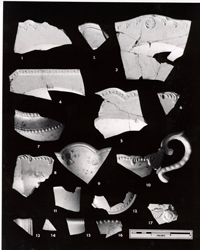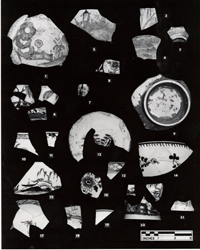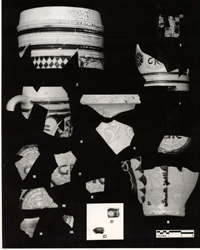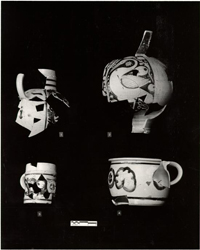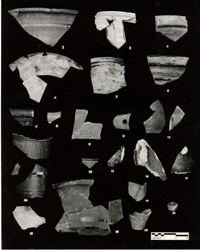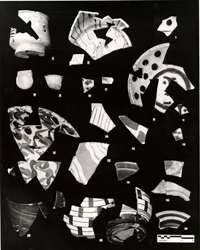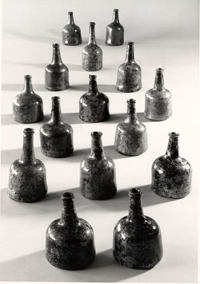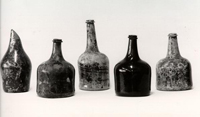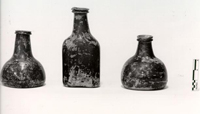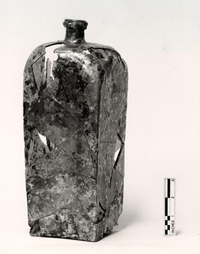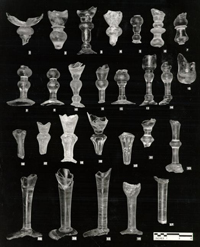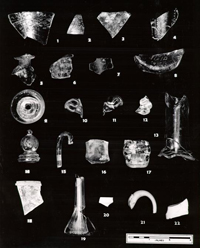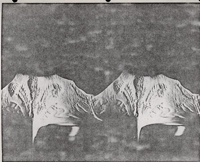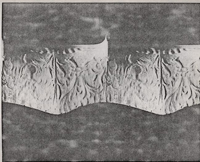Wetherburn's Tavern Archaeological Report, Block 9 Lot 20 & 21Originally entitled: "The Wetherburn Site - Volume 11 Part 3 Ceramics (cont'd), Glass, and Pipeclay Objects"
Colonial Williamsburg Foundation Library Research Report Series - 1181
Colonial Williamsburg Foundation Library
Williamsburg, Virginia
1990
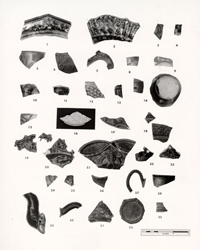 Figure 1 - Whieldon-Wedgwood Ware
Figure 1 - Whieldon-Wedgwood Ware
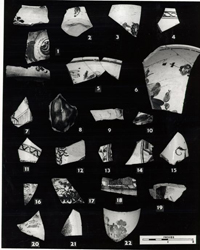 Figure 3 - Hand-painted and Transfer-painted
Figure 3 - Hand-painted and Transfer-painted
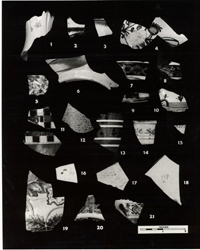 Figure 4 - Pearlware and Creamware
Figure 4 - Pearlware and Creamware
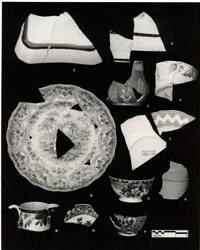 Figure 5 - Pearlware and White Earthenware
Figure 5 - Pearlware and White Earthenware
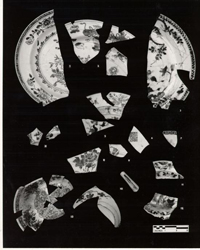 Figure 7 - Chinese Export Porcelain
Figure 7 - Chinese Export Porcelain
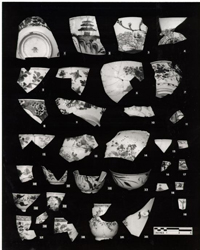 Figure 8 - Chinese Export Porcelain
Figure 8 - Chinese Export Porcelain
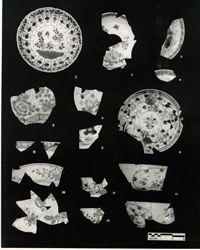 Figure 9 - Chinese Export Porcelain
Figure 9 - Chinese Export Porcelain
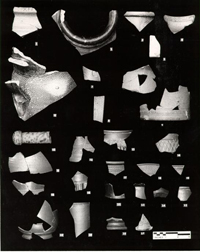 Figure 12 - English and American Stonewares
Figure 12 - English and American Stonewares
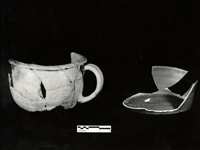 Figure 13 - Nottingham Stoneware and Colono-Indian
Figure 13 - Nottingham Stoneware and Colono-Indian
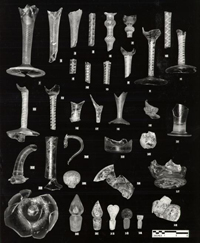 Figure 21 - Wine Glasses and Table Glasses
Figure 21 - Wine Glasses and Table Glasses
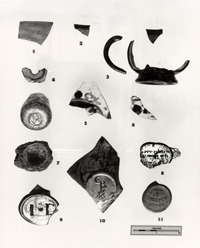 Figure 23 - Colored and Enamelled Glass and Bottle Seals
Figure 23 - Colored and Enamelled Glass and Bottle Seals
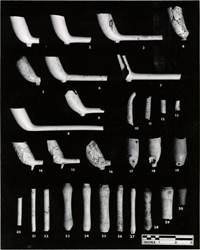 Figure 24 - Tobacco Pipes and Wig Curlers
Figure 24 - Tobacco Pipes and Wig Curlers
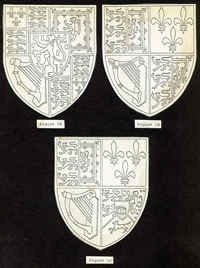 Figures 1A, 1B and 1C - Three Shields
Figures 1A, 1B and 1C - Three Shields
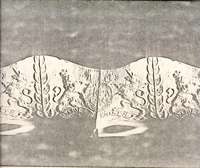 Plate I - Photograph of Artifact
Plate I - Photograph of Artifact
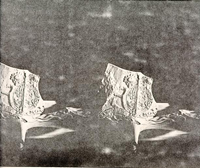 Plate II - Photograph of Artifact
Plate II - Photograph of Artifact
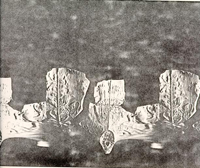 Plate III - Photograph of Artifact
Plate III - Photograph of Artifact
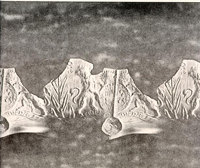 Plate IV - Photograph of Artifact
Plate IV - Photograph of Artifact
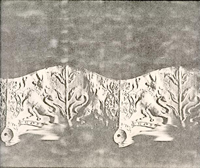 Plate V - Photograph of Artifact
Plate V - Photograph of Artifact
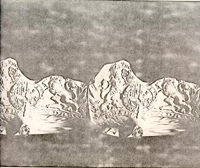 Plate VI - Photograph of Artifact
Plate VI - Photograph of Artifact
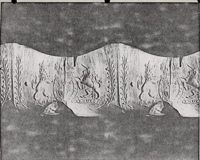 Plate VII - Photograph of Artifact
Plate VII - Photograph of Artifact
 Plate VIII - Photograph of Artifact
Plate VIII - Photograph of Artifact
THE WETHERBURN SITE
Block 9, Area N Bldg 31
Colonial Lots 20 and 21
REPORT ON THE ARCHAEOLOGICAL EXCAVATIONS OF 1965-1966
Volume II, Part 3
CERAMICS (cont'd), GLASS, AND PIPECLAY OBJECTS
| Table Of Figures | |
| Bibliographic Abbreviations | |
| Introduction | |
| Description of Artifacts | |
| Appendix I | Royal Arms Tobacco Pipes |
| II | Stratigraphic Associations |
| III | Photographic Negative Numbers |
| Figure 1. | Whieldon-Wedgwood Wares. |
| 2. | Creamware. |
| 3. | Hand-Painted and Transfer-Printed Creamware. |
| 4. | Pearlware and Creamware. |
| 5. | Pearlware and White Earthenware. |
| 6. | English Porcelain. |
| 7. | Chinese Export Porcelain. |
| 8. | Chinese Export Porcelain. |
| 9. | Chinese Export Porcelain. |
| 10. | German Stonewares. |
| 11. | German Stonewares. |
| 12. | English and American Stonewares. |
| 13. | Nottingham Stoneware and Colono-Indian Pottery |
| 14. | Coarsewares. |
| 15. | Slipwares. |
| 16. | Cherry bottles. |
| 17. | Cherry bottles. |
| 18. | Cherry bottles. |
| 19. | Case bottles. |
| 20. | Wine glasses. |
| 21. | Wine glasses and Table glass. |
| 22. | Table glass. |
| 23. | Colored and Enamelled glass and bottle seals. |
| 24. | Tobacco Pipes and Wig Curlers. |
| Beurdeley , | M.: | Porcelain of the East India Companies. London, 1962. |
| Boney , | K.: | Liverpool Porcelain of the Eighteenth Century and its Makers. London, 1957. |
| Cooper , | R.G.: | English Slipware Dishes. 1650-1850. London, 1968. |
| Earle , | C: | The Earle Collection of Early Staffordshire Pottery. London 1915. |
| Finer and Savage , | A. and G. | The Selected Letters of Josiah Wedgwood. London, 1965. |
| Godden , | G.A.: | Encyclopedia of British Pottery and Porcelain Marks. New York, 1964 |
| Hay , | The Anthony Hay Site, Report on the Excavations of 1960. Volumes I and II by Ivor Noël Hume. | |
| Hobson , | R.L.: | Catalogue of the Collection of English Pottery ... in the British Museum. London, 1903. |
| Honey , | W.B.: | Wedgwood Ware. London, 1948. |
| Hughes , | G.B.: | English and Scottish Earthenwares 1660-1860. New York, 1961. |
| Leeds Pottery , | Designs of sundry articles of Queen's or Cream-colour'd Earthen-Ware manufactured by Hartley, Greens, and Co. at Leeds-Pottery. Original in the Library of the Victoria and Albert Museum, London, 1783. | |
| Mankowitz , | W.: | Wedgwood. London, 1953. |
| Post Office , | The Post Office Site. Report on the Archaeological Excavations of 1961. Vol. I by Ivor Noël Hume, November 1961, Vol. II by Audrey Noël Hume, 1970. | |
| Rackham , | B.: | Early Staffordshire Pottery. London, 1951. |
| Rackham Schreiber , | Catalogue of English Porcelain, Earthenware, Enamels and Glass collected by Charles Schreiber, Esq., M.P. and the Lady Charlotte Elizabeth Schreiber. Vol. II. Earthenware. London, 1930. | |
| Ravenscroft , | The Ravenscroft Site. Report on the Artifacts Excavated during 1954 by Audrey Noël Hume. Revised 1962. | |
| Tait , | H.: | Bow Porcelain. 1744-1776. London, October 1959. |
| Thorp , | W.A.: | A History of English and Irish Glass. London, 1929. |
| Travis . | The Travis House Site. Report on the Excavations of 1961-1963. Volume I by Ivor Noël Hume. Volume II by Audrey Noël Hume. | |
| Towner , | D.C.: | The Leeds Pottery. London, 1963. |
| Watkins , | C.M.: | "North Devon Pottery and its Export to America in the 17th Century." U.S.N.M. Bulletin No. 225, Washington, D.C., 1960. |
| Watkins, and Noël Hume : | The Poor Potter of Yorktown. U.S.N.M. Bulletin No. 249, Washington, D.C., 1967. | |
| Watney , | B.: | English Blue and White Porcelain of the Eighteenth Century. London, 1963. |
| Wedgewood, and Ormsbee : | Staffordshire Pottery. New York, 1947. | |
| Wills , | G.: | English and Irish Glass. London, 1968. |
| Wetherburn , | The Wetherburn Tavern Site. Report on the Archaeological Excavations of 1965-1966. Interim Report by Ivor Noël Hume, Volume I, Part 2 by Glen Kirk, Volume II, Part I by Audrey Noël Hume. Volume II, Part 2 by Audrey Noël Hume. Volume II, Part 3 by Audrey Noël Hume. | |
INTRODUCTION
The site whereon stands the building known as Wetherburn's Tavern (Block 9, Colonial Lots 20 and 21) on the south side of Duke of Gloucester Street was leased by Colonial Williamsburg in 1964. At this time it was known locally as the Bull's Head but was renamed in honor of its most interesting eighteenth-century landlord. Henry Wetherburn's tavern-keeping interests were not confined to Lots 20 and 21, due in large part to two marriages to tavern owners' widows, though he appears to have operated the establishment that now bears his name from 1743 until 1760.
The archaeological excavation of Colonial Lots 20 and 21 were spread over a period of more than two years. Although there had been widespread disturbances, mostly caused by gardening and the erection of outbuildings, there had been little modern construction on the site and no previous archaeological digging. For this reason a large number of undisturbed archaeological deposits were encountered. At the same time the disturbed areas yielded quantities of excellent though unstratified eighteenth-century artifacts. While it was obviously pointless to count the number of fragments found, a rough estimate produced a figure of 200,000--not including animal bones, nails, bottle glass, or shells.
In order to make this report more readily usable, it was decided to divide the whole into several parts. The first (dealing with the two colonial wells) and the second (concerned with delftware, saltglaze and their related wares) are already completed. This, the third part deals with the remaining ceramics, the glass, tobacco pipes, and wig curlers. The small finds and iron objects remain to be described in the final, and fourth part of this report.
Each fragment has been given a tentative date before which it could not have entered the ground. This does not mean that it was deposited at that date, but only anytime thereafter. No attempt has been made to put a date of manufacture to each sherd but the reader is referred, where possible, to dated items of comparable shape or decoration. Items stated to have come from disturbed deposits had been uprooted from their original resting place in the course of the long life of the site.
All items are assumed to be of British origin unless otherwise noted.
Appendix II contains a complete listing of the stratigraphic associations of objects in Parts 2 and 3.
Figure 1. Whieldon-Wedgwood Wares
- 1.Fragment of octagonal, notched-edged plate with creamware body and lead glaze stained with manganese ("tortoiseshell").
Date of deposit: post 1760. 3379. E.R. 1115M-9.N. - 2.Rim fragment of wavy-edged plate with molded dot, diaper, and basket design. The creamware body is covered with a lead glaze stained with manganese (tortoiseshell), the bowl is shallow. Two other fragments almost certainly from this plate were found in the overlying layer. One of these, a base sherd, indicates that in addition to the manganese, copper was put into the glaze on the front of the plate to produce green patches. The reverse of the plate is tortoises3hell in appearance.
Date of deposit: post 1785. 3380. E.R. 1043A-9.N. - 3.Fragment of plate of cream-colored earthenware with plain rim and apparently scalloped edge, manganese staining to produce a tortoiseshell appearance.
Disturbed deposit. 3383. E.R. 1052A-9.P. - 4.Rim fragment of mold-made leaf tray with creamware body and lead glaze to which manganese has been added (tortoiseshell) on the upper surface; and copper oxide on the lower surface.
Date of deposit: post 1785. 3384. E.R. 1054A-9.N. - 5.Fragment of small thin bowl with everted rim, creamware body and lead glaze to which copper, cobalt, manganese oxide have been added to produce a mottled effect on both faces.
Date of deposition: post 1775. 3382. E.R. 1125L-9.N. - 6.Rim sherd of globular teapot which has been severely burnt. The body appears to be creamware with a plain lead glaze on the interior and with unidentifiable coloring agents applied to the exterior glaze. The rim is recessed to take a flush lid and there is a thin cordon immediately below it.
Date of deposit: post 1810. 3416. E.R. 1012B and 1012D-9.N. - 7.Crabstock handle from a tea or punch pot, creamware body covered with a lead glaze to which manganese has been added (tortoiseshell). A similar handle is seen on an unglazed redware teapot commemorating the marriage of George III and Queen Charlotte in 1761
(Rackham , Schreiber
, plate 33b, No. 240.) and on an enamelled white salt teapot of "about 1765", (Rackham
, plate 78.)
Date of deposition: post 1775. 3389. E.R. 1126L-9.N. - 8.Rim of teabowl with creamware body, ochre yellow and purplish-grey manganese being added to the clear glaze on both faces to produce a mottled grey surface with yellow patches. Two more fragments of this teabowl were found in the area, [3390. E.R. 1179K-9.N., 3390C. E.R. 1179J-9.N.].
Date of deposition: post 1810. 3390A. E.R. 1179K-9.N. - 9.Base of teabowl with thin, finely-potted footring and globular body. The creamware body is covered on the interior and exterior of the bowl by a clear glaze to which a purplish-gray stain and manganese have been added, a large patch of the latter on the inside of the base and a sprinkle on the exterior. No coloring agents were added to the glaze applied to the interior of the foot. There may be a connection between No. 9 and the rim No. B.
Date of deposition: post 1820. 3391. E.R. 1039A-9.N. - 10.Body fragment of vessel, possibly a teapot, with creamware body and glaze on interior. The exterior
has been crudely rouletted and colored by means of manganese and yellow ochre added to the glaze.
Disturbed deposit. 3392. E.R. 1017-9.N. - 11.Fragment of round, flush-fitting teapot lid with exterior rouletting and glazing identical to no. 10. The interior of the lid, the lower edge of the flange and the outer side of the collar have a clear yellow-firing glaze. Other items of this ware of which fragments were found included four teapots, one teabowl, two slop bowls, and two plates with the dot, diaper, and basket molding.
Date of deposition: post 1765. 3393. E.R. 1008M-9.N. - 12.Rim fragment of bowl with creamware body, molded on exterior with pineapple design below a cordon. The leaves are covered with a green glaze while the body of the fruit has a deep yellow glaze. This is the "pineapple" ware perfected by Josiah Wedgwood and used for tea and table wares. This bowl appears to be an unusual item for which an extant parallel cannot be found at the time of writing. However, as a New York Gazette advertisement quoted in Wedgwood and Ormsbee
, p. 108-109, lists bowls of cauliflower ware as well as "mugs, salts, mustard pots and pickle leaves," it is likely that such items were also made
in pineapple ware. A small fragment of another bowl with a slightly more everted rim was found elsewhere on the site (3398. E.R. 1017B-9.N.].
Disturbed deposit. 3397. E.R. 1116-9-N. - 13.Small green-glazed fragment of tea or coffeepot with handle of creamware body, molded on the exterior with a design of overlapping leaves. This could belong to either the pineapple or cauliflower wares of Wedgwood.
Date of deposit: post 1785. 3399. E.R. 1123G-9.N. - 14.Base and body fragment of small "melon" teapot, decorated with close horizontal bands of rouletted dots and glazed with bands of green and yellow. The interior has a clear glaze as does the flat base. For a similar teapot, see Honey
, plate 1.
Date of deposit: post 1790. 3396. E.R. 1017W,1049-9.N. - 15.Rim sherd of sugar bowl lid of cauliflower ware, developed by Josiah Wedgwood about 1760. The "flower" area is uncolored, while the leaves are green.
Date of deposition: post 1765. 3394. E.R. 1040D-9.N. - 16.Slightly domed lid of tea or coffeepot of cauliflower ware, the creamware body being completely covered with a clear glaze. The flange and the rim are both square cut.
Date of deposition: post 1765. 3395. E.R. 1054C-9.N. - 17.Rim sherd of platter in the Queen's shape, but with a crude bead and reel molding at the edge. The back is plain, the creamware body is covered on both sides by the brilliant green glaze perfected by Wedgwood in 1759-1760 and later used by many other English potters.
Date of deposit: post 1780. 3401. E.R. 1029N-9.N. - 18.Two fragments of plates of the Queen's shape and with barley molding on the rim. The body is creamware and is covered on both faces with the green glaze developed by Wedgwood between 1759 and 1760 and used by him and other English potters.
Disturbed deposit. 3402. E.R. 1039-9.N. - 19 & 20.Three fragments of an oval fruit dish or stand for a fruit basket with creamware body covered on both faces with the brilliant green glaze perfected by Josiah Wedgwood between 1759-1760 and used by him
and other potters in the succeeding decade and a half. The rim decoration consists of alternative panels of trellis and of basket weave on which stylized fruits appear. For a fragment of a similarly decorated teapot found in the well [3377. E.R. 1135F-9.N.] see Wetherburn Volume II, Part 1, Figure 5, No. 6. From each lattice zone a cluster of fruit and leaves spreads out onto the plain base of the dish. Four base fragments were found in the vicinity of the rim sherds. The edge consists of alternative outward and inward facing shallow gadroons. For a similar dish in clouded ware see Earle, page 121, No. 179. In June 1965 Queen Charlotte ordered "6 green fruit baskets and stands edged with gold" from Josiah Wedgwood (see Finer and Savage
, p. 34.).
Disturbed deposits. 3381. E.R. 1017, 1030, 1033, 1040, 1047, 1048D, 1067, 1068, and 1069-9.N. - 21.Rim fragment of molded plate, creamware body and, covered on both faces with the brilliant green glaze perfected by Josiah Wedgwood between 1750-1760 and used by him and other potters in the period 1760-1775. The outer section of the rim consists of a series of stylized "vines" intertwining to form four linking figures of eight. The area in the
center of the vines is plain but from each intersecting point a cluster of fruit or berries. The bowl is plain while the area of the rim between the cluster is covered with a random decoration of an incised dot enclosed by an incised circle. The quality of the molding is greatly inferior to that of a similar plate found in the well, [3385. E.R. 1135R, and 1135S, and 1135T-9.N.], see Wetherburn, Volume II, Part 1, Fig. 6, center. Fragments of one or more plates comparable to the latter were found in several areas to the north, west and east of the kitchen [3387. E.R. 1030D, and 1030E, and 1125, and 1125E-9.N., 3388. E.R. 1108-9.N., 3389. E.R. 1054-9.N.]. Another fragment of this plate was found in the topsoil immediately to the north [3386. E.R. 1069-9.N.].
Date of deposit: post 1770. 3386A. E.R. 1040C-9.N. - 22 & 23.One rim and one body fragment (possibly associated) of molded leaf-shaped trays or dishes, creamware body and covered with the green glaze perfected by Josiah Wedgwood in 1759. Both pieces are poorly molded and thick.
Disturbed deposit. 3417. E,.R. 1067A-9.N. 3418. E.R. 1151-9.N. - 24.Rim sherd of molded leaf-shaped tray or dish with creamware body and covered with the green glaze perfected by Josiah Wedgwood in 1759. A comparable tray appears in Mankowitz
, Plate II. Fragments of three other trays of this type were found on the site.
Disturbed deposit. 3419. E.R. 1021-9.N. - 25.Rim sherd of tray in pickle leaf with foxglove molding, the creamware body covered with the same green glaze as Nos. 17-24.
Disturbed-deposit. 3402. E.R. 1069-9.N. - 26.Vertical collar and sloping shoulder fragment of teapot of Jackfield type stoneware. The globular vessel represented by this fragment usually possessed a crabstock spout and handle and had tripod, mask feet.
Date of deposit: post 1760 3409. E.R. 1012E-9.N. - 27.Portion of small strap handle of Jackfield type stoneware, probably from a cup or milk pitcher. Like No. 26, this heavily burnt fragment was found in the orange, brick yard spread between the tavern and the kitchen.
Date of deposit: post 1760 3410. E.R. 1012 and 1033B-9.N. - 28.Rim sherd of slop bowl of Jackfield-type stoneware.
Disturbed deposit. 3411. E.R. 1008-9.N. - 29.Short, broad ogee-curved crabstock teapot spout of Jackfield-type stoneware with four strainer holes in the body of the teapot at the point where it is luted on.
Date of deposit: post 1785. 3412. E.R. 1049F-9.N. - 30.Upper portion of round-sectioned handle from teapot or pitcher of Jackfield-type stoneware.
Date of deposit: post 1785. 3413. E.R. 1165F-9.N. - 31.Fragment of base of pitcher of red-black-glazed stoneware of Jackfield-type. This fragment is heavily burnt and like nos. 26 and 27 was found in the fire debris between the kitchen and the tavern, (see Wetherburn Interim Report, page 41). The footring is wide, the body globular, thick and crudely potted. Other items of this ware of which fragments were found included a small pitcher, another large pitcher similar in style to No. 31 and a flat-bottomed, flaring-sided vessel of unusual form.
Date of deposit: post 1760. 3414. E.R. 1126D-9.N. - 32.Base of small bowl of Jackfield-type stoneware with square cut footring and steeply flaring sides. This fragment like nos. 26, 27, and 31 was found in the fire debris between the kitchen and tavern. It has been burnt so heavily that its ware cannot be identified with certainty, however, its texture suggests a creamware body.
Date of deposit: post 1760. 3415. E.R. 101OC-9.N. - 33.Rim sherd of flaring bowl of agate ware covered with a clear glaze producing a brown and yellow effect.
Date of deposit: post 1780. 3412. E.R. 1123J-9.N.
Figure 2. Creamware
- 1.Rim fragment of scallop-edged, deep yellow plate with molded fleur-de-lys design below a single beaded line. A similar fragment was found in a trash deposit made between 1782-1790 at the Travis House site, (see Travis
, Vol. II, Figure 7, No. 17, 3163. E.R. 532B-14.G.).
Date of deposit: post 1790. 3421. E.R. 1043A-9.N. - 2.Rim fragment of plate in the Queen's shape, pale yellow in color.
Date of deposit: post 1769-70. 3422. E.R. 1117B-9.N. - 3.Section of round, flat-bottomed plate of pale yellow creamware with molded rim design of widely spaced groups of three fronds. A fragment of similarly decorated bowl was found in the filling of a cellar hole on the Post office Site which seems to have occurred between 1765-1770, see Post Office, Figure 27, No. 7. This design appears on item 86 (a strawberry dish and stand) in the 1783 Design Book of the Leeds Pottery, see Leeds Pottery
, page 19.
Date of deposit: post 1810. 3423. E.R. 1005C-9.N. - 4.Rim fragment of pale straw-colored, octagonal plate with poor quality diamond molding at edge.
Disturbed deposit. 3424. E.R. 1009-9.N. - 5.Section of large platter in the Queen's shape but without the vertical division, with diamond molding as No. 4 close to the edge, flat base and pale yellow in color.
Date of deposit: post 1790. 3425. E.R. 1165T-9.N. - 6.Rim fragment of pale cream, octagonal plate with feather-edge molding.
Disturbed deposit. 3426. E.R. 1009-9.N. - 7.Rim of cylindrical teapot of deep cream colour with a row of large beaded molding at the neck and a similar row at the junction of the sloping shoulder and the body. For similar teapot see Towner
, plate 31B.
Date of deposit: post 1820. 3426.E.R. 1017A-9.N - 8.Section of feather-edged plate with radiating ribs on the sides and rim, deep cream in color. For a dish probably from the same mold, but transfer-printed
with the "Liver" birds, see Hobson
, plate 30, No. 17.
Date of deposit: post 1790. 3428. E.R. 1114C-9.P. - 9.Rim sherd of wavy-edged, round dish. The buff body contains numerous brown particles while the glaze has fired to a pale cream color. Date of manufacture:
Date of deposit: post 1770. 3429. E.R. 1112A-9.N. - 10.Rim section of deep cream, feather-edged sauceboat with crudely molded scroll-type handle. The latter has large beading on each edge, a flat area between, the thumb grip is grooved latitudinally.
Disturbed deposit. 3430. E.R. 1017 and 1033-9.N. - 11.Rim sherd of small, thinly potted teabowl. The rim is everted and the surface is a pale straw in color.
Disturbed deposit. 3431. E.R. 1009-9.N. - 12.Lid of creamware teapot with thin, square-cut collar and a band of well defined bead-and-reel decoration above the flange. Deep cream in color. A similar lid appears on a punch pot in Towner
, plate 26B, which
is identified as "Leeds, circa 1770".
Date of deposit: post 1775. 3432. E.R. 1165T and 1165W-9.N. - 13.Rim sherd of small shell-shaped sweetmeat dish of deep cream colour with ridges radiating from the handle. A similar dish shown in Towner
, plate 27A is marked "Leeds * Pottery" and attributed to the period "circa 1765".
Disturbed deposit. 3433. E.R. 1158H-9.N. - 14.Small fragment of molded leaf tray, deep cream in color and with poor molding.
Date of deposit: post 1760. 3434. E.R. 1020D-9.N. - 15.Everted and off-set rim of small pot of pale straw color. The upper exterior edge of the rim is beaded.
Date of deposit: post 1765. 3435. E.R. 1034C-9.N. - 16.Rim sherd of flaring bowl with heavily beaded edge. This fragment has been burnt, obscuring its original color.
Disturbed deposit. 3436. E.R. 1012-9.N. - Poorly molded floral motif possibly from a tureen lid. The molding of the flower is too poor for accurate identification and at the time of writing no parallel could be found for either it or the leaves. Disturbed deposit. 3436. E.R. 1112-9.N.
Figure 3. Hand Painted and Transfer Printed Creamware
- 1.Neck, body, and base fragment of tea caddy with slightly recessed base, cylindrical body and slightly everted neck. The much-crazed body is deep cream in color and enamelled on the exterior in red, black and green, the floral motifs including a full-blown rose.
Disturbed deposit Neck fragment 3450. E.R. 1009-9.N. Body fragment 3451. E.R. 1009A-9.N. Base fragment 3452. E.R. 1008-9.N. - 2.Base fragment of small teabowl with inward sloping foot ring and enamelled on exterior with a floral device in black, green and red.
Date of deposit: c.1830. 3453. E.R. 1048D-9.N. - 3.Rim sherd of teabowl of pale cream color. The interior has a single enamelled red line close to the rim and the exterior has a similarly executed floral motif in red and black.
Date of deposit: post 1770. 3454. E.R. 1024D-9.N. - 4.Rim sherd (interior shown) of creamware bowl with hand painted red-enamelled, "figure-of-eight" design enclosed at top by a single and below by a double line. The exterior has a floral motif enamelled in red, green and black.
Disturbed deposit. 3455. E.R. 1021-9.N. - 5.Rim sherd of saucer, plain on exterior, enamelled red band below interior rim and floral decoration enamelled in yellow and green with black outlining.
Date of deposit: post 1770. 3456. E.R. 1030 and 1031G and 1058-9.N. - 6.Section of saucer, pale cream in color with wedge-shaped footring. The interior is enamelled in a floral design with red, green and black and there is a single red line close to the rim.
Date of deposit: post 1825. 3457. E.R. 1005C-9.N. - 7.Body sherd of tankard, pale cream in color, enamelled on the exterior with red fence or gatepost to the left of which green and black foliage appears. This is in the school of David Rhodes who was working in Leeds from 1760-1768 and afterwards in London where he was employed by Josiah Wedgwood. It is likely that his
style was continued at the enamelling shops of the Leeds Pottery for some years after his departure. A teapot found at the Ravenscroft Site [1819-28.F.4]1 and almost certainly enamelled by Rhodes or his employees, has a similar fence design with the foliage painted in a larger size than this fragment. A similar design appears on a teapot lid in Towner, Leeds, plate 2, which is attributed to the period "about 1760". The poor quality of the Wetherburn fragment, however, would suggest a later date.
Disturbed deposit. 3458. E.R. 1112-9.N. - 8.Sprigged ornament of unknown form coloured with brown before glazing, possibly part of a lid of a tureen.
Disturbed deposit. 3459. E.R. 1001A-9.N. - 9.Fragment of flat, flanged teapot lid of deep cream creamware with sprigged leaf decorated with underglaze brown.
Date of deposit: post 1780. 3460. E.R. 1040A-9.N. - 10.Body fragment of cream-colored earthenware teabowl or cup, plain on interior and with blue hand-painted oriental design on exterior.
Disturbed deposit. 3892. E.R. 1165-9.N. - 11.Body fragment of tankard with black transfer printed design consisting of an oval cartouch border enclosing the word "commerce."
Date of deposit: post 1790. 3893. E.R. 1114C-9.P. - 12.Body fragment of tankard with black transfer printed design of floral wreaths.
Date of deposit: post 1825. 3894. E.R. 1142B-9.P. - 13.Small fragment of pitcher with black transfer design of a central oval scene or motif bordered by a vine.
Date of deposit: post 1820. 3855. E.R. 1067A-9.N. - 14.Body fragment of pitcher with black transfer printed design in oval cartouch. The character of the design cannot be ascertained.
Disturbed deposit. 3896. E.R. 1067-9.N. - 15.Portion close to spout of pitcher with black over-glaze, hand-painted device possibly an initial. This sherd was inadvertently photographed inverted.
Disturbed deposit. 3897. E.R. 1052A-9.P. - 16.Fragment of tankard with black transfer printed design; since this was photographed, a further
joining sherd has been found which confirms the animal as a running rabbit or hare, part of a hunting scene.
Date of deposit: post 1820. 3898. E.R. 1003D and 1004-9.N. - 17.Extremely thick rim sherd of large bowl with a single black hand-painted line on the interior of the rim and a black transfer printed design of a tree on the exterior.
Disturbed deposit. 3899. E.R. 1021-9.N. - 18.Fragment of a pitcher with black, transfer printed design of a sailing ship. Four other pieces of this item were found elsewhere in the vicinity [E.R. 1012N,1012, and 1030, and 1012B-9.N.].
Disturbed deposit. 3900. E.R. 1012-9.N. - 19.Fragment of base of bowl with black transfer printed sailing ship in the center.
Date of deposit: post 1790. 3901. E.R. 1124P-9.N. - 20.Fragment of small bowl or teapot plain on interior, the exterior has a maroon transfer printed decoration, the character of which cannot now be determined.
Date of deposit: post 1825. 3902. E.R. 1049B-9.N. - 21.Fragment of tankard, plain interior and maroon transfer-printed decoration of undeterminable character on the exterior.
Disturbed deposit. 3903. E.R. 1030D-9.N. - 22.Rim sherd of small can, plain interior with exterior design transfer-printed in green showing a cottage in the distance and a young man in the foreground.
Date of deposit: post 1790. 3904. E.R. 1162H-9.P.
Figure 4. Pearlware and Creamware
- 1 & 4.Spout and body fragment of pearlware quintal horn later found to be possibly of the same object. No. 4 was photographed horizontally instead of vertically, the right hand sherd should be at the top. The spout is shell edged and blue painted, the body sherd has a hand-painted decoration in a palette of gold, yellow, brown and blue. A similarly decorated horn is shown in Hughes
, plate 24.
Date of deposit: post 1825. Spout 3901. E.R. 1046-9.N. Body fragment 3902. E.R. 1050A, and 1050E, and 1052A-9.N. - 2.Small rim fragment of scalloped-edged vessel of creamware, probably a sauce boat, and with blue, hand-painted underglaze design resembling the blue edging on pearlware.
Disturbed deposit. 3903. E.R. 1055-9.P. - 3.Rim sherd of small pearlware bowl with blue edging below slightly rolled rim.
Disturbed deposit. 3904. E.R. 1124-9.N. - 5.Fragment of pearlware tankard, plain interior and with polychrome floral decoration in a palette of blue, orange, yellow, and brown.
Disturbed deposit. 3905. E.R. 1046A-9.N. - 6.Base fragment of pearlware bowl, with wedge-sectioned footring within which the base is recessed. Plain interior, underglaze exterior decoration in gold and brown.
Mid-eighteenth-century deposit. 3906. E.R. 11O8B-9.N. - 7.Sherd of pearlware tankard with plain interior, exterior underglaze decoration of a brown band with a yellow figure of eight design on top. Below this band is a zone of vertical fluting.
Date of deposit: post 1780. 3907. E.R. 1114C-9.N. - 8.Fragment of tankard of pearlware, plain interior, exterior band of dark brown on which an encircling floral motif of yellow berries, chrome-yellow stalks and green leaves has been painted.
Disturbed deposit. 3913. E.R. 1113-9.N. - 9.Fragment of creamware teapot lid with wide flange and brown-painted upper surface to the rim. The main portion of the lid is decorated with brown-painted vertical bands which appear to radiate from the area of the knop.
Disturbed deposit. 3914. E.R. 1018-9.N. - 10.Fragment of domed pearlware teapot lid with flange. The latter is decorated with a narrow brown band, the domed portion has a hand-painted design consisting of a wide chrome-yellow band interrupted by a brown "rock" outlined in the same yellow and topped by a green leaf protruding from a brown A similar spray but with a triple green leaf springs from the yellow band. An identical pattern appears on two fragments of a pearlware bowl found in the filling of a cellar in area 15.B. of the Post Office site [3915. E.R. 417C-15.B.]. This latter deposit was made c.1820. For further details see the Post Office, Volume I, page 19ff.
Date of deposit: post 1815. 3916. E.R. 1112B-9.N. - 11.Two fragments of a pearlware mug, the interior plain. The main portion of the body has been decorated by the sgraffito method to produce a checkerboard
design in black, brick-red, blue, and the natural pearlware surface. The lower zone is covered with a blue glaze.
Date of deposit: post 1782. 5141. E.R. 1053, 1046-9.N. - 12.Body fragment of small cylindrical vessel of creamware, the interior plain, the exterior covered with a blue glaze containing particles of undissolved coloring matter.
Disturbed deposit. 5143. E.R. 1009-9.N. - 13.Body fragment of small barrel-shaped vessel of creamware with horizontal bands cut through the mottled brown glaze to expose the body.
Date of deposit: post 1770. 5142. E.R. 1066A-9.N. - 14 & 15.These fragments were inadvertently not mended together before photography. Fragment of small straight-sided jar of canary ware with thickened rim and exterior transfer-printed design of a horizontal band of oak leaves and below this the word "TRIFLE".
Disturbed deposit. 5144. E.R. 1022, and 1039A-9.N - p70
- 16.Base fragment of pearlware plate with impressed mark JB for which no identity can be found.
Disturbed deposit. 6028. E.R. 1070-9.N. - 17.Base sherd of pearlware plate with impressed mark,
PHILLIPS
LONGPORT
Godden , page 491, suggests that this mark was in use by the Staffordshire Pottery between 1822 and 1834.
Disturbed deposit. 5145. E.R. 1093-9.N. - 18.Base sherd of pearlware plate, the upper surface with a blue transfer-printed design-showing an infant on a horse in a rural setting. The plain reverse has the impressed mark, I H. Godden
, page 318 identifies this as the mark of either J. Heath of Hanley (in production c.1780-c.1800)or John Heath of Derby for whom no dates are given. As it is likely that this plate was not made until a decade later than the work period of the J. Heath mentioned above, the mark might possibly belong to John Heath of the Sytch Pottery in Burslem between 1809-1822.
Disturbed deposit. 5146. E.R. 1011-9.N. - 19.Body fragment of large basin of white ware with a blue transfer-printed decoration on both faces depicting a grape vine. Items with the same pattern have been found at the Post office site [2936. E.R. 417A-15.B.], at the Travis House site [3704. E.R. 447C, 462A-14.G.] and at the James Geddy House [3911. E.R. 1306D and 1311F-19.B.]. Unfortunately only the Travis House fragment was in a stratified deposit, being associated with a pearlware sherd of the first quarter of the nineteenth century.
Disturbed deposit. 5147. E.R. 1001C-9.N. - 20.Rim fragment of dish or tray of pearlware, plain exterior, interior blue transfer-printed decoration and pierced design on rim and lower side.
Disturbed deposit. 5155. E.R. 1164-9.N. - 21.Spout fragment of pitcher with leaf decoration molded on exterior, interior with blue transfer printed design.
Date of deposit: c.1800. 5156. E.R. 1004L-9.N.
Figure 5. Pearlwares and White Earthenwares
- 1.Portion of square tureen lid of pearlware with crudely molded gadroons over which blue underglaze color has been applied and then feathered upward in imitation of the edging of pearlware plates of the period 1782-1825.
Date of deposit: post 1840. 5140. E.R. 1001 and 1001A-9.N. - 2.Fragment of square (or rectangular) tureen lid of pearlware with raised, molded festoons of flowers, two rows of raised "molded leaves" (one close to the flange and the other above the festoons), each covered with a band of blue (underglaze). Knop missing.
Date of deposit: post 1840. 5141. E.R. 1001 and 1001A and 1001C-9.N. - 3.Small pitcher, pearlware body, small footring within which the base is recessed. The exterior has alternating vertical leaves in relief (colored green} and relief foxglove flowers (colored pink and green). Around the neck is a green garland in relief. Spout and handle missing.
Date of deposit: post 1840. 5142. E.R. 1001A and 1001C-9.N. - 4.Fragment of lower portion of large pitcher of white earthenware, plain on interior and with blue transfer-printed design of flowers and leaves on the exterior. On the fragmentary base is half of a blue transfer-printed mark with the word "Asiatic" superimposed on a leaf. A plate also excavated on the site (5158. E.R. 1113-9.N.) has the complete mark which reads "Asiatic Plants."
Date of deposit: post 1840. 5157. E.R. 1001C-9.N. - 5.Two fragments of round plate of white ware with small footring within which the base is slightly recessed. The rim is dished. The back is plain except for a transfer-printed mark consisting of "VANDYKE" (denoting the pattern) and "S.A. & Co.", (the mark of Samuel Alcock and Co. of Cambridge and Burslem between 1830 and 1859). There is also an impressed "X" denoting a batch. The front bears a blue transfer-printed decoration consisting of a rim design of Gothic character and a central scene of the same type.
Date of deposit: post 1840. 5159. E.R. 1001C-9.N. - 6.Round wavy edge plate of white ware, the back plain save for the impressed mark,
T MAYER
STOKE
Godden , page 423, identifies this mark as belonging to Thomas Mayer of the Cliff Bank Works, Stoke being used by them in the period 1826-1835. The front of the plate has a red transfer print, the rim portion being floral and the central design showing an elephant and howdah by a river and some large Indian-type buildings.
Date of deposit: post 1840. 5160. E.R. 1001C-9.N. - 7.Small bowl of white ware with black transfer-printed floral design on interior and exterior. There is a tall, flaring footring within which the base is recessed, the latter being a transfer-printed mark and the legend "JESSAM, OPAQUE C[HINA], B.B.& [." This is a mark used by Baker, Bevan and Irwin, the Glamorgan Pottery, Swansea, Wales in the period 1813-1838.
Date of deposit: post 1840. 5163. E.R. 1001A and 1001C-9.N. - 8.Portion of small pitcher of earthenware fired to a chrome yellow and coated externally and for a
short distance internally with a clean lead glaze. The mid section has a band of fine beading, a band of bead and reel, five cordons and enclosed by a band of bead and reel and of beading. The base is recessed within a square-cut foot.
Date of deposit: post 1840. 5630. E.R. 1001C-9.N. - 9.Upper portion of pitcher of white ware with rounded spout, slightly flaring rim and handle with trifed leaf-like terminal for small strap handle. The exterior is decorated with a stencilled design of flowers and leaves with a wide blue band around the rim.
Date of deposit: post 1840. 5631. E.R. 1001A and 1001C-9.N. - 10.Section of saucer of pearlware, plain exterior but with interior transfer-printed border with birds of various types, some in cartouches and with a central design possibly chinoiserie in character. The printing is in an extremely dark blue which has flowed in to the surrounding areas. This would seem to be an early example of printing by transfer on pearlware.
Disturbed deposit. 5632. E.R. 1138-9.N. - 11.Teabowl of pearlware with exterior completely covered with blue transfer-printed design mainly floral in character. The rim covered with a brown band and an interior border design with oriental influence and a quatrefoil motif in the bowl's center. The base is recessed with a square-cut foot.
Date of deposit: post 1800. 5633. E.R. 1145-9.N.
Figure 6. English Porcelain
- 1.Lid of punch or large teapot, knob missing with blue hand-painted decoration of chinoiserie character. While it has not been possible to find a comparably decorated object, the design incorporates some features of two items of Bow porcelain. Both are illustrated in Tait
, the inkpot, dated 1750, (Figs. 9 and 10) has identical clouds while a pitcher, dates 1754, (Figs. 20 and 21) show similar fencing and bamboo plants.
Date of deposit: post 1750 and possibly pre 1756. 5164. E.R. 1005 and 1011-9.N. - 2.Portion of bowl with plain interior, exterior with blue hand-painted chinoiserie design of a tall thin pagoda-like structure and some trees. The sherd is so heavily burnt that any attributions of origin are impossible.
Disturbed deposit. 5165. E.R. 1090G-9.N. - 3 & 4.Two fragments possibly from the same straight-sided tankard with plain interior and blue, hand-painted exterior decoration including willow trees and in an oriental landscape. The glaze is missing and
there has been a considerable breakdown of the surface, a feature which supports a Bow origin, c.1750-1760.
Upper sherd, disturbed deposit. 5166. E.R. 1108B-9.N. Lower sherd, date of deposit: post 1810. 5167. E.R. 1108E-9.N. - 5.Fragment of base of teacup, plain interior save for two concentric blue lines and with a similar pair of lines above the foot. The surface is covered with the thick brown deposit found on excavated Bow porcelain of the early period 1750-1760.
Date of deposit: post 1765. 5168. E.R., 1165G-9.N. - 6.Three fragments of one or more teabowls, the interior rim decorated in blue with a diaper border, the exterior with a blue, hand-painted design of oriental character with willow trees, peony and "Chinese Chippendale" fence.
Disturbed deposit. 5169. E.R. 1067, 1067A-9.N. - 7.Small center fragment of cutlery handle with blue hand-painted floral decoration. Identical handles have been found in other Williamsburg excavations.
at Dr. Barraud's house [1611-10.F.2.], at Burdette's Ordinary [1609-17.C.2.] and on Lot 269 (the northeast segment of the Botetourt and Nicholson Street junction, [1610-27.C.1.]. Mr. R.J. Charleston of the Victoria and Albert Museum identified these as being products of the Bow China Factory; from the period about 1750.
Disturbed deposit. 5170. E.R. 1017-9.N. - 8.Small fragment of base of plate, plain on the back, blue hand-painted decoration on front with a flower enclosed by a wreath of leaves with the latter's background infilled with blue in a wide band. Origin uncertain.
Date of deposit: post 1840. 5171. E.R. 1001C-9.N. - 9.Base of medium-sized bowl, no decoration, heavy square-cut footring within which the concave base is recessed. This fragment was covered with the brown scaley deposit usually found on excavated products of the Bow factory.
Date of deposit: post 1775. 5172. E.R. 1165W-9.N. - 10.Rim sherd of large bowl with blue hand-painted decoration consisting of a diaper band on the inside of the rim, a band of scrolls enclosed by two lines on the corresponding portion of the exterior and a design of uncertain character below.
Disturbed deposit. 5173. E.R. 1017-9.N. - 11.Rim sherd of bowl with blue hand-painted decoration above the molded vertical fluting. There is an internal diaper-type rim border. For a similarly decorated cup and saucer, see Boney
, plate 12H and page 173. Dr. Boney dates the illustrated pieces as "about 1775" and identifies them as products of the Liverpool potteries.
Disturbed deposit. 5174. E.R. 1017E-9.N. - 12.Base of bowl, plain on exterior but with blue hand-painted oriental trees and rocks in the interior center. This piece shows the undercut footring with a concave internal profile which is considered by Dr. K. Boney to be a characteristic form of Liverpool wares.
Disturbed deposit. 5175. E.R. 1008 and 1043 and 1108-9.N. - 13.Rim fragment of large bowl, plain interior and with blue hand-painted diaper border at interior edge.
Disturbed deposit. 5177. E.R. 1165-9.N. - 14.Rim and body portion of medium-sized bowl, dark blue, hand-painted floral decoration on exterior. Both interior and exterior of the rim have the same design, a simple line over a raw of inverted swags. For an identically decorated saucer see Watney
, plate 58b. It is attributed to the Liverpool factory of Philip Christian and Company.
Date of deposit: post 1775. 5178. E.R. 1125L-9.N. - 15.Portion of bowl with blue hand-painted exterior design of an oriental landscape and interior rim border design with a stylized flower.
Disturbed deposit. 5179. E.R. 1049-9.N. - 16.Center fragment of plate, plain back and with blue hand-painted flower on front.
Disturbed deposit. 5180. E.R. 1008A-9.N. - 17 & 18.Two fragments possibly from the same saucer with plain back, pale blue hand-painted decoration of an oriental landscape. For an identically decorated
saucer see Boney
, plate 11b. Dr. Boney gives the date of manufacture as "circa 1760-1765" and attributes it to Liverpool.
Disturbed deposit. 5181a,5181b E.R. 1043-9.N. - 19.Small rim fragment of saucer with plain back, two blue trees close to the inside rim and indications of more decoration towards the center.
Date of deposit: post 1810. 5182. E.R-. 1141S-9.N. - 20.The fragments of can with inside flat footring within which the base is slightly recessed. Plain interior and blue hand-painted exterior design of an oriental landscape to which additional overglaze accents in red have been added. Similarly decorated but larger cans in the Victoria and Albert Museum are identified as "Worcester, c.1750".
Date of deposit: post 1770. 5183. E.R. 1043A, 1043N, 1015L-9.N. - 21.Base of small can similarly to No. 20 blue with paler blue decoration (also of oriental character), also probably of same providence and date.
Date of deposit: post 1810. 5184. E.R. 1118K-9.N.
Figure 7. Chinese Export Porcelain
- 1.Left hand portion of round plate, the base recessed within unglazed foot, plain back, iron-oxide edge to the rim. All decoration is hand-painted, underglaze blue. Fragments of an identical plate were found elsewhere on this site, [5229. E.R. 1067, 1114C-9.N.].
Date of deposit: post 1775. 5226. E.R. 1123E-9.N. - 2.Three fragments of one or more round plates with design handpainted in blue under the glaze and with red and gold overpainting. The base is recessed within an unglazed foot, the edge is covered with iron oxide and close to the latter is a simple blue line. The rim is decorated with a miscellany of designs including vases, scroll boxes and flowers, the central area appears to include an urn of flowers on a stand.
Date of deposit: post 1765. Upper left-hand fragment: 5227a. E.R. 1014E-9.N.
Upper right-hand fragment: 5227b. E.R. 1014E-9.N.
Lower fragment: 5228. E.R. 1012D-9.N. - 3.Right-hand portion of round dish, the base recessed within an unglazed foot and decorated in underglaze blue with two concentric circles which possibly
enclosed a mark. Close to the exterior rim is a band of overglaze red painted diaper-type design and below this, peony sprays in underglaze blue and overglaze red. The rim is edged with iron oxide. The center of the plate has a floral design enclosed by a single blue line, above this are more floral sprays and close to the rim, a blue, underglaze diaper border. Unless specified, all decoration on this plate is in underglaze blue and overglaze red and gold. Fragments of another identically decorated dish were found on the site, [5231. E.R. 1030C, and E-9.N.].
Disturbed deposit. 5230. E.R. 1017A and B-9.N. - 4.Two fragments of plate with underglaze blue line at junction of rim; bowl and two other lines enclosing central area. The bowl is decorated with overglaze hand-painted decoration in red, green, and gold apparently consisting of a series of oval cartouches alternating with floral panels. Two blue lines on back.
Disturbed deposit. 5192. E.R. 1114-9.N. - 5.Section and center fragments of plate with base recessed within an unglazed foot. On the back of the
rim is a flowing design of blue stalks and red berries. The rim is edged with iron oxide. The centre of the plate is covered with a floral design in underglaze blue and overglaze red and gold. The bowl has a chinoiserie design of alternating diaper and floral cartouches. The rim is covered with flowing floral sprays in palette of red, gold, and blue. Fragments of more than one plate of this design were found on the site, nearly all in deposits of 1760-1780.
Deposited: post 1790. 5193. E.R. 1114C-9.N. - 6.Base fragment of plate bearing the reign mark of Chien Lung (1736-1795) on the exterior, painted-in underglaze blue. On the front of the plate is an overglaze hand-painted stylized character for long life surrounded by bats, painted in red, the former being used as a symbol for long life by Oriental painters.
Deposited: post 1765. 5194. E.R. 1165G-9.N. - 7.Small fragment of wide rim of round plate, iron oxide on edge close to which (on the front) is a band of crudely painted, dark blue diaper-like decoration. Below this is a small portion of a floral spray
painted extremely fine in a pale blue.
Date of deposit: post 1780. 5242. E.R. 116ST-9.N. - 8.Base fragment of thick dish or platter, plain back and front decorated with peonies in the famille rose palette.
Disturbed deposit. 5230. E.R. 1114-9.N. - 9.Small rim fragment of an octagonal plate, plain back, iron oxide on rim, and floral decoration covering the bowl and rim executed in blue underglaze with red, gold, green and black overglaze additions.
Date of deposit: post 1825. 5231. E.R. 1055A-9.P. - 10.Straight spout of small teapot, plain on upper surface and with simple, hand-painted herringbone design on the lower face.
Disturbed deposit. 5332. E.R. 1017-9.N. - 11.Rim sherd of small round fruit plate, plain exterior, iron oxide on the edge. The surfaces of this vessel show the same mouldings present on similar objects from other Williamsburg sites (see Hay
, Volume III, Part 1, Figure 29, No. 1). The decoration of the
Hay and Wetherburn plates are similar; the Hay example, however, lacks the iron oxide rim. Fragments of other dishes of this type were found in the fillings of both the Wetherburn [3771. E.R. 1135E-9.N.] and Geddy wells [5243. E.R. 1340G.J-19.B.].
Date of deposit: post 1785. 5244. E.R. 1020D-9.N. - 12.Base and side fragment of small fruit bowl, plain back and angled foot within which the base is recessed. The center is decorated with an oriental landscape enclosed by a diaper band infilled by oval cartouches containing a floral spray. The rim decoration appears to be floral in character. All the painting is blue and under the glaze.
Date of deposit: post 1790. 5245. E.R. 1114C-9.N. - 13.Fragments of two round sweetmeat dishes, the base recessed within an unglazed foot, the sides sloping and the outer rim thickened. The exterior is decorated with a stylized floral design surmounted by a diaper-floral band which is immediately below the thickened rim. The center of the bowl has a floral design, the sloping sides have floral sprays which are surmounted, by a diaper band close to the rim. Fragments of at least four of these bowls were found at this site and another base was excavated at Dr. Baraud's House, [5248-10.F.2.].
Left-hand fragment 5246. E.R. 1011B and E, 1026B, C, and D-9.N. Date of deposit: post 1750. Right-hand fragment 5247. E.R. 1011B, and 1026B-9.N. Date of deposit: post 1757.
Figure 8. Chinese Export Porcelain
- 1.Base of bowl with central floral motif enclosed by two concentric lines, the exterior with a landscape covering the sides, a tall foot within which the base is recessed. On the latter, enclosed by two concentric circles is the traditional Chinese symbol for happiness two fishes. The decoration is all hand-painted in blue and applied under the glaze.
Date of deposit: post 1740. 5249. E.R. 1004Z-9.N. - 2.Side fragment of thin bowl with plain interior, exterior decoration in blue, hand painted and under the glaze, depicting a pagoda and some rocks.
Date of deposit: post 1780. 5250. E.R. 1040J-9.N. - 3.Side fragment of bowl, plain interior and with blue, hand-painted, underglaze decoration including some rocks and a peony.
Date of deposit: post 1790. 5251. E.R. 1114C-9.N. - 4.Base fragment of bowl with decoration in blue, hand painted and under the glaze. The exterior design appears to have been floral in character, that on the interior consists of a peony from which curling tendrils flow.
The foot is tall with the lower edge unglazed.
Date of deposit: post 1820. 5252. E.R. 1108G-9.N. - 5.Body and rim portion of thinly-potted bowl; close to the interior of the rim is a band of leaves, the edge is painted with iron oxide; the exterior decoration is floral and in blue.
Date of deposit: post 1785. 5253. E.R. 1011B and 1011D-9.N. - 6.Rim and body fragment-of bowl, plain on interior except for a band of diaper pattern painted in red over the glaze with occasional oval cartouches containing a floral spray, the flowers in red overglaze, the leaves in underglaze blue with gold overpainting. The diaper band is enclosed by blue lines, the cartouches by blue, red, and gold lines. The exterior decoration appears to be an Oriental landscape partially painted in-blue before glazing and with red and gold overpainting and additional details like rocks also in red. The rim is covered with iron oxide. A similarly decorated fragment of a smaller bowl was found in the filling of the colonial well [3436. E.R. 1135H-9.N.] where it was deposited c.1765: see Wetherburn, Volume II, Part 1, Fig. 4, No. 23.
Date of deposit: post 1820. 3437. E.R. 1047A-9.N. - 7.Section of bowl with tall, thin foot within which the base is recessed, on the latter are two blue concentric circles which may have contained a mark. The exterior of the foot is decorated with two blue lines, the lower of which has been covered after glazing with a red line. There are two concentric blue lines at the junction of side and base and two more close to the rim. A red scroll-like design covers the upper pair of lines. The floral decoration of the exterior has the basic features painted in blue, (ante cocturam) with additional embellishments added later in red as was the band of swags above the foot.
Date of deposit: post 1750. 5250. E.R. 1052G and 1147R-9.P. - 8.Fragment of rim of large bowl with interior band of interlocking hexagons, each filled with lines radiating from a central circle. The exterior appears to be covered with wavy-edged cartouches, the spaces between being first covered with a spider's web design and flowers, the former being washed with blue. All decoration is hand painted in blue before firing.
Date of deposit: post 1790. 5261. E.R. 1114C-9.N. - 9.Fragment of base of bowl with tall, thin foot, unglazed on its lower edge and within which the base is recessed. A wavy-edged cartouche has been outlined by means of a white line of slip applied under the glaze and within this is an oriental scene with at least two figures. The area around the cartouche is decorated with floral sprays, which like the cartouche scene are handpainted in blue prior to firing. There apparently was a floral design in the center of the bowl. Fragments of a bowl larger but with similar decoration and also with the white outlined cartouches were found at the Anthony Hay site in deposits made between 1765-1775, [2582. E.R. 288 & 230C-28.D.].
Disturbed deposit. 5262. E.R. 1117D-9.P. - 10.Fragment from lower part of thick bowl, a double blue ring on the interior, a single underglaze blue ring on the exterior surmounted by floral decoration, the basis of the design being in blue applied before glazing and additional features being added in red and green after firing.
Date of deposit: post 1785. 5256. E.R. 1141P-9.N. - 11.Body fragment of bowl with plain interior and exterior
decoration of uncertain character executed in blue before glazing and with additional features added post-cocturam in red. Both surfaces of this fragment show the mottled effect noted on the fruit plate sherd shown in Figure 7, No. 11.
Date of deposit: post 1750. 5257. E.R. 1129F-9.N. - 12.Fragment of bowl with gentle, vertical fluting. On the interior is a blue hand-painted hand of diaper decoration broken occasionally by a chrysanthemum also in blue. The exterior design appears to be a series of vertical panels with different floral motifs. All decoration is handpainted in blue under the glaze.
Disturbed deposit. 5258. E.R. 1030D-9.N. - 13.Body fragment from large bowl, plain interior and with exterior decoration of large flowers in the "famille rose" palette.
Date of deposit: post 1795. 5259. E.R. 1008D-9.N. - 14.Base fragment of large bowl with tall foot within which the base is deeply recessed, the edge of the foot is unglazed. Both interior and exterior are
covered with a floral decoration in the "famille rose" palette.
Disturbed deposit. 5260. E.R. 1124-9.N. - 15.
Left. Rim fragment from flaring bowl, on the interior is a green band enclosed by red lines and overpainted with a scroll design in black. On the exterior a design of round "scales" has been applied in a white slip under the glaze.
Disturbed deposit. 5263. E.R. 1164-9.N.Right. Small fragment of plate rim, the upper surface with a diaper border in red-and green below which is an unidentified design in green and black. The underside of the fragment has a design probably floral in character painted in a white slip prior to glazing, the edge is banded with iron oxide.
Date of deposit: post 1770. 5264. E.R. 1168C-9.N. - 16.Small fragment of vertically-ribbed cup, whose edge and the crest of each ridge are outlined with blue on the exterior, the interior in underglaze blue and overglaze red seems to represent a vine.
Disturbed deposit. 5265. E.R. 1173-9.C. - 17.Rim fragment of bowl with interior decoration of red shell motifs enclosed by black lines and with red bands of swags and dashes below. On the exterior immediately below the iron oxide-painted rim is a wide black band and below this a small portion of a landscape scene also in red and black. The interior rim design is similar to that of No. 19.
Disturbed deposit. 5266. E.R. 1017-9.N. - 18.Two sherds of bowl with iron oxide rim, the left hand sherd showing the exterior decorations apparently of an Oriental temple roof, the basic design being in underglaze blue with red and gold overpainting. The right hand sherd shows the interior border of diaper panels and oval cartouches with a central floral spray. The basic design is painted in blue prior to glazing and the red and gold details are overpainted after glazing.
Disturbed deposit. 5268. E.R. 1017-9.N. - 19.Small rim sherd of teabowl or cup, all decoration is over the glaze, on the interior is a rim design of red wheel-like motifs outlined and enclosed in
black. on the exterior is the trunk of a tree painted with a fine brush in pale brown.
Disturbed deposit. 5269. E.R. 1008-9.N. - 20.Fragment of small bowl, plain interior save for a double line close to the rim, two similar lines close to the exterior rim below which is a floral decoration, hand painted in cobalt under the glaze. Date of deposit: post 1755. 5270. E.R. 1122G-9.N.
- 21.Teabowl with everted rim, wedge-sectioned foot (unglazed at edge) within which the base is recessed. There is a single blue line below both the interior and exterior of the rim, also at both junctions of the sides and the base, there is a trace of a small area of unidentifiable decoration in the center of the bowl. The main part of the exterior has a blue, hand-painted underglaze floral design, finely executed but in some places poorly infilled with blue. Date of deposit: post 1760. 5271. E.R. 1002G and 1003N-9.N.
- 22.Teabowl, plain interior, crude foot within which the plain base is recessed, the glaze has failed to cover the junction of the sides and foot at a
number of places, exposing the body beneath. The sides are decorated with a willow tree and flowers, the basic elements being applied in blue prior to glazing which additional details have been added in red after glazing. A small rim fragment of an identically decorated teabowl was found elsewhere on the site in a deposit made post 1755, [5294. E.R. 1123E-9.N.].
Date of deposit: post 1785. 5272. E.R. 1011D, and 1020D, and 1127A-9.N. - 23.Fragment of finely-made bowl with a slightly everted, iron oxide painted rim, on the interior there is a single blue line at the base of the sides and another immediately below the rim; attached to the latter is a row of scroll-like devices in blue from which pendent leaves and flowers have been added in red after glazing. The exterior decoration consists of a stalk of "barley" and some unidentified flower. In both cases the salient features have been painted in blue before glazing with additional details in red and gilt, added after glazing.
Date of deposit: post 1760. 5273. E.R. 1014F-9.F. - 24.Section of teabowl, small foot (unglazed at edge) within which the base is recessed. The interior is undecorated, the exterior with a floral design, the leaves painted in blue before glazing, the flowers applied afterwards in red and gilt.
Date of deposit: post 1760. 5274. E.R. 1126E-9.N. - 25.Fragment of teabowl, plain interior save for a single blue line close to the rim. The exterior design consists of a circular cartouche formed by large blue leaves to which has been added after glazing floral spray in red and gold.
Date of deposit: post 1755. 5275. E.R. 1148G-9.N. - 26.Body fragment of small mug or can, plain interior and with exterior hand-painted scene depicting some kind of timber construction with a crate or coffin in the foreground. The whole executed after glazing in a palette of black and red.
Date of deposit: post 1785. 5276. E.R. 1165L-9.N. - 27.Rim and body fragment of can, plain interior, close to the iron oxide painted rim is a band of diaper decoration applied in red after glazing between two blue underglaze bands, in addition
a red line has been applied over the lower blue one. The body of the can is decorated with a floral design, the leaves being applied in blue before glazing, the flower and some further leaves being added in red after glazing, some of the latter are crosshatched, others infilled with a red wash.
Date of deposit: post 1750. 5277. E.R. 1011D and 1011E-9.N. - 28.Rim sherd of can, plain interior, iron oxide-painted rim, band of diaper decoration below rim and floral motifs below, all handpainted in blue prior to glazing.
Date of deposit: post 1783. 5278. E.R. 1068A-9.N. - 29.Tall cup with slightly flaring rim, small foot within which the base is recessed. The interior is plain except for a small floral device in the base and single blue line close to the rim. The exterior has a plain zone above the foot separated from the main area of floral decoration by a single blue line and with a band of diaper pattern close to the rim.
Date of deposit: post 1760. 5279. E.R. 1009B, C. and Q-9.N. - 30.Rim and upper body sherd of straight-sided tankard, plain interior, iron oxide, on the rim, the upper handle terminal has a leaf painted on either side and portions of a tree appear to its left. All decoration is blue and handpainted prior to glazing. Fragments of a similar tankard were found at the Anthony Hay site [5281. E.R. 749H-28.D.] in a deposit made c.1770-1780.
Date of deposit: post 1740. 5280. E.R. 116BE-9.N.
Figure 9. Chinese Export Porcelain
- 1.Round saucer with wavy edge and molded, vertical fluting extending halfway up the sides. The foot is small and unglazed, the back plain. The front has a central design of a flowing plant and a bug, the vertical flutes are outlined and each is filled with a trefoil leaf (washed with blue) from the top and bottom of which emerges a sideways figure 3 on a stalk. In the smooth zone above, there are horizontal sprays of a flower and leaves. All decoration is hand painted in blue under the glaze. A fragment of a similarly decorated saucer was found elsewhere on this site in a deposit made post 1795 [5292. E.R. 1108B-9.N.].
Date of deposit: post 1765. 5283. E.R. 1165G-9.N. - 2.Portion of round saucer, small foot within which the base is recessed, plain back and everted rim. Only a portion of the design on the front remains and it depicts a vase of flowers on a stand on a table and a moth-like insect hovering above. Close to the edge is a narrow band of diaper decoration. All decoration is hand painted in blue under the glaze.
Date of deposit: post 1840. 5284. E.R. 1001A, and 1001C-9.N. - 3.Section of saucer, wedge-sectioned foot within which the base is deeply recessed and plain back. The front has a central decoration apparently showing a landscape, the whole enclosed by a double circle. Close to the rim is a band of diaper design, poorly painted in blue under the glaze.
Date of deposit: post 1755. 5285. E.R. 1123E-9.N. - 4.Rim portion of saucer, plain back, central design of unknown character, rim border of large flowers separated by small leaves painted in blue under the glaze.
Date of deposit: post 1750. 5286. E.R. 1125K-9.N. - 5.Center portion of saucer, (heavily burnt) with wedge-sectioned foot within which the base is recessed. The central design consists of a peony on the left and a flowing flower on the right, all decoration in blue and under the glaze.
Date of deposit: post 1765. 5287 E.R. 1011A, and 1026B, and 1026C-9.N. - 6.Section of saucer with small foot within which the base is recessed, plain back and slightly
everted rim. The front is decorated with a floral design, basic leaves being painted in blue before firing, a large flower, more leaves and a bud being added after firing in red and gold, further detail then added in gold to the blue leaves.
Date of deposit: post 1780. 5288. E.R. 1127A-9.N. - 7.Section of saucer with wedge-shaped foot within which the base is recessed, plain back and slightly everted rim. The basic floral design has been applied in blue before glazing, additional leaves and flowers have been added in red after firing as have the gold details on the leaves.
Date of deposit: post 1765. 5289. E.R. 1165G-9.N. - 8.Saucer with thick, wedge-sectioned foot within which the base is recessed, plain on the back except for two crudely-painted motifs each with blue trailing stalks painted before glazing and red flowers applied after firing. The front is elaborately decorated with a single flower and leaves in the center enclosed by a blue line, between this and the narrow band of diaper design at the iron oxide-painted rim is a tight design of flowers and leaves, the basic details being
applied in blue before firing; additional details being added in red and gold after glazing.
Date of deposit: post 1770. 5293. E.R. 1002N, and 1002S-9.N. - 9.Two fragments of two large bowls with slightly everted rims, the left hand fragment is photographed to show the interior with a complicated band of red and blue decoration both colours applied under the glaze. The exterior as seen in the right hand fragment has pendent branches of grapes at the rim and "humps" infilled with lines; the spaces between being filled with dark blue. Below this band the character of the design cannot be determined.
Disturbed deposits. Left hand fragment: 5290. E.R. 1165-9.N. Right hand fragment: 5291. E.R. 1161-9.N. - Items 10-13 could conceivably refer to the following entry in the inventory of Henry Wetherburn (Dec 19 1760) which comprised among other things "1 Set White flowered China 1 Tea Pot and Stand 1 Slop Bason Sugar Dish Tea Cannister 7 Cups 8 saucers Spoon and Tong stands 6 Coffee Potts and 1 Plate" The whole set was valued at £ 1 "6" Od .
- 10.Rim and center fragments of plate, the base recessed within an unglazed foot, the back plain. The front decoration consists of floral sprays above the rim and similar floral motifs in the center. Close to the rim is a base of double red lines infilled with gold which form a scroll design immediately over each of the floral sprays. A similar band of red and gold appears at the junction of the sides and the plate's center. All decoration is overglaze and a palette of red, green, white, pink, and black was used for the floral sprays. Plates with a similar border devices appear to have been manufactured in the period of 1750-1770. See Beurdeley
, plate XIX.
Date of deposit: Rim: 5067a E.R. 1023A-9.N. Center: 5067b. E.R. 1025B, and 1018C, and 1025C, and 1023-9.N. - 11.Section of teabowl with tall foot within which the base is recessed, slightly everted rim. The inside is plain save for a decorative band consisting of an upper straight red line and a similar lower line with loops at intervals, the space between being filled with gilt. The
exterior is decorated with a floral design in a pallette of green, red, and white all being outlined in black.
Date of deposit: post 1750. 5259. E.R. 1001D, and 1011E-9.N. - 12.Portion of teabowl with wavy edge, interior and exterior decoration identical to that on No. 11.
Date of deposit: post 1780. 5296. E.R. 1117D-9.P. - 13.Two fragments of slop bowl with brown edged rim and with similar decoration to the plate No. 10. The internal decoration consists of a double red line infilled with gold close to the rim.
Date of deposit: post 1775. 5026. E.R. 1009M, and 1009S-9.N.
Figure 10. German Stoneware
- 1.Upper body and rim portion of large tankard with multiple reeding highlighted with two bands of cobalt below which is a zone of incised diamond pattern with alternate rows infilled with cobalt. This decoration is divided in two by a crowned medallion which apparently comes from the same mold as that on a jug excavated on a site on Francis Street [5299-2.G.2].
Date of deposit: post 1755. 5397. E.R. 1123E-9.N. - 2.Body fragment of tankard with checkered design alternate squares being infilled with cobalt. This design was applied after a GR medallion had been sprigged on to the body.
Disturbed deposit. 5298. E.R. 1008-9.N. - 3.Lower portion of tankard with multiple cordons highlighted with two bands of cobalt. Above this is an extremely poor GR medallion on which the initials are enclosed by a wreath. To its left is a crudely-cut, multi-petalled flower infilled with cobalt.
Date of deposit: post 1760. 5300. E.R. 1008N, and 1008P, and 1009M-9.N. - 4.Upper portion of body and handle of tankard, multiple cordons two of which are highlighted with cobalt, below this a geometric pattern partially infilled with cobalt.
Date of deposit: post 1760. 5301. E.R. 1016C-9.N. - 5.Rim and body fragment of jar of grey stoneware with wide everted rim, squared on its edge and undercut. The wide upper surface of the rim is covered with sprigged panels consisting of a flower with a leaf on either side. Larger but similar designs are sprigged on the lower portion of the body. A rim sherd of a smaller vessel was excavated at the Moody House [5303-2.C] and a fragment of a much smaller one was found at the Custis Site in a deposit of the early nineteenth century, [5304. E.R. 932D, and 933B-4.B.].
Date of deposit: post 1785. 5302. E.R. 1165H, and 1165L-9.N. - 6, 7 & 10.GR medallions from three large jugs, all from similar though not necessarily the same mould. In each case there is a bird on either side of the crown which is of the same design. In the case of No. 7, part of the medallion has become fused with another vessel and the quality of the moulding is very poor. Only one other jug with this medallion has been excavated in Williamsburg, on the Moody House lot [5305. 2.C.].
- 6.Date of deposit: post 1785. 5306. E.R. 1029A-9.N. 7.
- 7.Date of deposit: post 1755. 5307. E.R. 1030F, and 1123E-9.N. 10. Date of deposit: post 1760. 5308. E.R. 1069A-9.N.
- 8.Lower half of medallion and base portion of large jug with geometric decoration. The medallion appears to be of the same type as No. 6, 7, and 10 and of a kind found only once before in Williamsburg, at the Moody House [5303-2.C.].
Date of deposit: post 1795. 5311. E.R. 1008A, and 1008B-9.N. - 9.Small portion of GR medallion showing only the lower part of the initials and the center of the cherub.
Disturbed deposit. 5312. E.R. 1030F-9.N. - 11.Fragment of jug neck with multiple reeding and painted with cobalt.
Disturbed deposit. 5312. E.R. 1107-9.N. - 12.Small body fragment of jug decorated with sprigged flowers, highlighted in cobalt against a ground of purple.
Date of deposit: post 1780. 5313. E.R. 1178C-9.C. - 13.Small fragment of round handle from large bowl, the upper surface has incised circles and has been painted with cobalt. A bowl excavated at the Governor's Palace, (70-20.A.18] has a similar decoration of the body, and is of comparable size.
Date of deposit: post 1790. 5314. E.R. 1053C-9.P. - 14.Fragment of porringer handle with multi-reeding and painted in cobalt.
Disturbed deposit. 5315. E.R. 1140-9.P.
Figure 11. German Stonewares
- 1.Portion of jug with multi-cordoned neck, two cordons being highlighted with cobalt, the body is decorated with a geometric design, parts of which are infilled with cobalt. The round-sectioned handle has a rattail on its lower terminal with a dab of cobalt on the end.
Date of deposit: post 1750. 5316. E.R. 1001E, and 1001F, and 1001G, and 1008Q-9.N. - 2.Portion of large jug with multi-reeded neck painted with manganese, the body decorated with a pair of large pelican like birds and presumably a GR medallion between. The rounded handle has a rattail terminal overstamped with a leaf design, the body is pear-shaped, the base flat with cordons above.
Date of deposit: post 1780. 5317. E.R. 1020B, and 1040F, and 1040G-9.N. - 3.Small cylindrical tankard, four cordons below rim, only one of which is highlighted with cobalt. The central part of the body bears a geometric design, portions of which are infilled with cobalt. The handle is a thick strap with an-exterior central keel, there is a single hole close to its junction with the body. Immediately to the right of the
handle is an incised 6 denoting its capacity.
Date of deposit: post 1750. 5066. E.R. 1008B, and 1008K, and 1020D, and 1030D, and 1030F, and 1067A-9.N. - 4.Chamber pot with flat rim, cordons below, main portion of the body decorated with sprigged lions and incised rosettes, both outlined with cobalt, the center of the rosette's being likewise coloured, flat base, thickened strap handle with twin ridges on its exterior surface.
Date of deposit: post 1765. 5318. E.R. 1165, and 1165C, and 1165G-9.N.
Figure 12. Brown Stoneware
- 1.Fragment of large storage jar, the rim square cut, everted and dished on its inner surface to receive a lid. Incised into the upper edge of the rim are the figures XIII, applied post cocturum.
Disturbed deposit. 5319. E.R. 1012-9.N. - 2.Portion of neck of jar with rolled rim which has been dipped in iron oxide. There is a cordon at the head of the shoulder.
Date of deposit: post 1750. 5320. E.R. 1147R-9.P. - 3.Neck fragment of small jar with rolled rim from which the body appears to slope outwards.
Date of deposit: post 1770. 5321. E.R. 1049B-9.N. - 4.Fragment of jar with sloping collar-type rim, dished in the interior to take a lid. The shoulder slopes sharply outwards.
Disturbed. deposit. 5322. E.R. 1128A-9.N. - 5.Base fragment of cylindrical jar, pale buff-grey on both surfaces, flat base with slanting cutting
at outside.
Disturbed deposit. 5323. E.R. 1117-9.P. - 6.Upper portion of globular jug, rolled rim, multi-cordoned neck to which the upper handle terminal is attached. The lower end of the handle is luted to the body, drawn into a rattail and then thumb printed above the latter. A similar jug was excavated at the Anthony Hay cabinet shop site in a deposit prior to 1740.
Date of deposit: post 1730. 5324. E.R. 1017T-9.N. - 7.Small body fragment of brown stoneware, Fulham-type tankard with stamped, oval excise mark of a crowned WR.
Disturbed deposit. 5325. E.R. 1120-9.N. - 8.Strap handle from tankard made at the Rogers' factory in Yorktown, Virginia, in operation in the second quarter of the eighteenth century, see Watkins and Noël Hume
, page 91 ff.
Date of deposit: post 1750. 5326. E.R. 1115D-9.N. - 9.Base and body fragment of cylindrical tankard,
cordons above the flat base and the upper portion coated with iron oxide before firing.
Date of deposit: post 1770. 5327. E.R. 1124P, and 1124Q, and 1124R-9.N. - 10.Handle of pipkin, hollow with round end; a product of the Rogers' factory at Yorktown, Virginia, which was in operation during the second quarter of the eighteenth century, see Watkins and Noël Hume , page 91, ff. Date of deposit: post 1740. 5329. E.R. 1032-9.N.
- Nos. 11-19 all show the white line between body and glaze acknowledged by most authorities to be present on products of the Nottingham stoneware kilns.
- 11.Body fragment of a large pitcher, (probably pear-shaped) with a single groove on the shoulder.
Disturbed deposit. 5328. E.R. 1017, and 1018-9.N. - 12.Rim fragment from. pitcher or tankard, probably pear-shaped with multiple reeding.
Date of deposit post 1785. 5331. E.R. 1017B-9.N. - 13.Rim of tankard with double groove above a plain zone
and below this a band on which small particles of clay have been sprinkled. The main body area has carved vertical flutes.
Date of deposit: post 1750. 5333. E.R. 1001E, and 1045E-9.N. - 14.Body fragment of cylindrical tankard with double cross-hatching above and below plain zones.
Date of deposit: post 1790. 5334. E.R. 1043A-9.N. - 15.Body fragment of cylindrical tankard with a plain zone above which is a band of zigzag rouletting.
Date of deposit: post 1760. 5335. E.R. 1069A-9.N. - 16.Body fragment of cylindrical tankard with an upper zone to which small particles of clay have been applied, below this a plain band and at the bottom vertical carved flutes.
Date of deposit: post 1765. 5336. E.R. 1112-9.N. - 17.Rim of heavily fired bowl, rolled and slightly everted rim, below the body is decorated with bands of wavy lines interspersed with various notches or dots.
Disturbed deposit. 5337. E.R. 1112-9.N. - 18.Flaring rim of large loving cup with horizontal bands of rouletting separated by a cordon.
Date of deposit: post 1755. 5338. E.R. 1123E-9.N. - 19.Rim sherd of bowl or loving cup with vertical fluting below a plain zone.
Date of deposit: post 1745. 5339. E.R. 1047M-9.N. - Items 20 through 26 have a shiny brown surface, are thinner and do not have the white line which was present on items 11 through 20; they are believed to be the products of potteries in the Staffordshire and Derbyshire areas.
- 20.Lower portion of tankard, waisted above a small foot, then increasing in diameter and becoming cylindrical. There is a single groove on the lower part of the body. The base is recessed within the foot. The exterior is a pale chestnut brown in colour.
Disturbed deposit. 5340. E.R. 1161D, and 1162D-9.P. - 21.Rim sherd of cylindrical mug with two grooves below rim.
Date of deposit: post 1785. 5341. E.R. 1108S-9.N. - 22.Base fragment of small can, wide foot within which the base is recessed, the body flaring slightly above the foot.
Date of deposit: post 1800. 5342. E.R. 1116A-9.P. - 23.Rim fragment of small, scalloped-edged patty pan with deep sloping sides.
Date of deposit: post 1810. 5343. E.R. 1040F-9.N. - 24.Base fragment of small dish, probably of similar shape to No. 23.
Disturbed deposit. 5344. E.R. 1021-9.N. - 25.Rim of small can, slightly flaring and with band of rouletting below thickened edge.
Disturbed deposit. 5345. E.R. 1161D-9.N. - 26.Fragment of pedestal base, rouletted along its lower edge. The body emerges from the foot almost horizontally, the fragment would appear to be part of a bowl.
Disturbed deposit. 5346. E.R. 1108B-9.N. - 27.Base fragment of tankard with flat base, sides slightly incurving and covered on both sides with a slip. There are a series of cordons above the base and the body appears to be decorated with a design of incised lines and rouletted zones. This is a typical product of eighteenth-century kilns in the Burslem area.
Date of deposit: post 1770. 5347. E.R. 1047E-9.N.
Figure 13 Colono-Indian and Nottingham Wares
- Left: Chamber pot of Colono-Indian pottery with shell tempering, everted and down rolled rim, wide, thick strap handle luted to the body below the rim.
Date of deposit: post 1775. 5348. E.R. 1165W-9.N. - Right: Oval relish or salad dish of lustrous brown salt-glazed stoneware showing the white line between glaze and body which is generally considered to be characteristic of the wares of the Nottingham potteries. The base is flat, the rim rolled and the sides slope slightly outwards. A smaller but identically shaped dish was found on the Post Office site, in the filling of an unlined cellar hole which also contained over 1100 broken beverage bottles whose shapes suggested a date of 1755-1765 for the deposit. 1
Figure 14. Coarsewares
- Rim of thick bowl, the body fired almost to stoneware and dark red in colour. Both surfaces have been covered with an engobe and then with thick lead glaze which fired to a deep chrome yellow. The rim has been everted and flattened on its upper edge, there is a cordon below. on to the lower point of the fragment the engobe did not adhere to the body which shows black through the glaze. Another fragment of this vessel was found on the adjoining site, [E.R. 1181C-9.C.].
Date of deposit: post 1755. 5350. E.R. 1123E-9.N. - Rim and body portion of dish with everted rim, partially rolled which has then been cut away on the interior to form a flat ledge; the interior covered with a clear lead glaze and which fired to a rich yellow, the back is unglazed.
Disturbed deposit. 5351. E.R. 1108F, and 1108N-9.N. - Rim fragment of gravel-tempered earthenware with gently curving, golded rim. Only the interior is covered with a lead glaze which has fired to a pale apple green. This vessel is a product of the North
Devon potteries which were actively producing it in the first and second quarters of the eighteenth century, see Watkins
, page 19, ff.
Date of deposit: post 1785. 5352. E.R. 1017B-9.N. - Section through dish of buff coloured earthen-ware with flat base and wide, upward sloping rim. The front is covered with a thick glaze to which iron or manganese has been added causing it to fire to a dark blackish brown.
Date of deposit: post 1775. 5353. E.R. 1012C and 1012D and 1067B-9.N. - Section of dish of buff coarseware (as No. 4) with flat base and narrow dished rim. The interior is covered with a thick lead glazing containing iron or manganese which has fired to a blackish brown. A portion of another dish of this type but with more narrow and less dished rim was found elsewhere on the site in a deposit made post 1752, [5354. E.R. 1011E. 9.N.].
Date of deposit: post 1775. 5354. E.R. 1020D and 1039A and 1039H-9.N. - Rim sherd of red earthenware storage jar with straight sides, rolled rim below which is a sharp cordon. The whole covered with a clear lead glaze which has fired to a rich brown.
Disturbed deposit. 5356. E.R. 1040V-9.N. - Rim sherd of dish or pan of red-bodied earthen-ware, both surfaces covered with a lead glaze containing particles of iron (?) which has fired to a grey-brown. The rim is folded and has been undercut on the inside with four small cordons below it on the exterior.
Date of deposit: post 1770. 5357. E.R. 1020K-9.N. - Small fragment of rim of chamber pot, buff body covered with lead glaze which fired to an apple green tone, a single groove close to the edge.
Date of deposit: post 1770. 5357. E.R. 1020D-9.N. - Section through pan with slightly flaring sides, flat base and with three grooves below the exterior of the rim and two grooves immediately above the base. The buff body contains the flecks
of brick earth which characterize the Tidewater Virginia clays and it seems likely that this was a product of the Rogers pottery at Yorktown which operated in the second quarter of the eighteenth century, see Watkins
, page 91,ff.
Date of deposit: post 1750. 5359. E.R. 1115C, and 1115D, and 1115J-9.N. - Sherd of small pot of buff clay covered on both faces with a clear lead glaze which contained impurities which fired as black specks. The rim is rolled. These pots are found on most Williamsburg sites in deposits of the third quarter of the eighteenth century. Origin unknown. Probably English.
Disturbed deposit. 5360. E.R. 1049-9.N. - Handle of coarseware bird or martin bottle, red buff body and covered with a lead glaze, undoubtedly a product of the Rogers' family pottery at Yorktown, Virginia, in operation during the second quarter of the eighteenth century, see Watkins and Noël Hume , page 91, ff. Unlike the handle of the bird bottle found at the James Geddy House [3539. E.R. 987D and 1329A-19.B.], the hole (through which the perching stick was passed) is right against the body. Date of deposit: post 1765. 3282. E.R. 1153B-9.N.
- Two body fragments of another bird or martin bottle. The right hand sherd shows the interior point where the lower perch hole passes through the body.
Date of deposit: post 1770. 5361. E.R. 1054B-9.N. - Fragment of coarseware chaffing dish, extremely thick and with one hole improperly punched. The lead-glazed buff body with flecks of brick earth identifies this as a product of Rogers' family pottery in Yorktown, Virginia in operation during the third quarter of the eighteenth century, see Watkins and Noël Hume, page 91, ff. Another fragment of a similar object was found elsewhere on the site, [5406. E.R. 1014N-9.N.] in a disturbed deposit.
Date of deposit: post 1750. 5405. E.R. 1019K-9.N. - Possible chaffing dish fragment, lead-glazed buff body with brick earth flecks identifying it as a product of the Rogers' family kilns at Yorktown, Virginia, see Watkins and Noël Hume
, page 41, ff. The sides which have multi-cordoning immediately above the flat base, slope inwards at a sharp angle. At one point the sides are cut through, a fact which suggests a chaffing dish. The sharp incline of the sides preclude its being a bird bottle. It is conceivable that No. 13 and 14 belong to the same vessel.
Date of deposit: 5407. E.R. 1014F-9.N. - Upper body fragment of coarse earthenware money box, buff body with brick-earth flecks which identify it as a product of the Rogers' family in Yorktown, Virginia, see Watkins and Noël Hume
, page 91, ff., in the period 1724 to 1745. There is a lead glaze on the exterior, the knop is missing.
Date of deposit: post 1800. 5408. E.R. 1145R-9.P. - Three fragments of straight sided tankards of buff-grey stoneware, each covered on both faces with a thick lead glaze. The strap handle of the
lower fragment is crudely luted onto the body and there are a pair of cordons above the flat base. This is typical of the items produced at the potteries in the Burslem area of Staffordshire in the first half of the eighteenth century.
Upper fragment 5408. E.R. 1168C-9.N. Date of deposit: post 1765. Lower hand fragment 5409. E.R. 1008Q-9.N. Date of deposit: post 1770. Right hand fragment 5410. E.R. 1009X-9.N. Date of deposit: post 1760. - Rim fragment of bowl of Colono-Indian pottery with everted rim and burnishing on exterior surface.
Date of deposit: post 1770. 5411. E.R. 1108F-9.N. - Section of pan of variegate red and yellow-bodied coarseware with internal glazed fired black, folded rim, flat base and pronounced potting rings in the interior. This is a product of the Buckley (North Wales) kilns who were exporting such items to the American colonies
throughout the first, second and third quarters of the eighteenth century.
Date of deposit: post 1785. 5412. E.R. 1119M-9.N. - One spout of a triangular-mouthed crucible with traces of use.1
Date of deposit: post 1755. 5413. E.R. 1054D-9.N. - Base of small triangular-mouthed crucible, apparently unused, coarse grey ware.
Date of deposit: post 1755. 5414. E.R. 1148F-9.N. - Base fragment of small crucible with deposit of once molten metal still within the interior, pale grey, coarse body.
Disturbed deposit. 5415. E.R. 1174-9.P
Figure 15. English and American Slipwares
- 1.Small handled mug of buff clay with a slip of a similar material, decorated with thin horizontal trails of a manganese-stained slip and then everted in a clear lead glaze while held by the foot, (which remains unglazed). The base is flat, the rim everted and the strap handle is luted to the body with no terminals. This cup lacks the manganese dots usually associated with this ware and form but two other such vessels found in Williamsburg also are dotless. One of these, similar in size to the Wetherburn example [2315. E.R. 579E-14.G.], was excavated at the Travis House Site in a group of artifacts deposited between 1782-1790, see Travis, Volume I, Part 1, page 23, and Volume II, Figure 5, No. 4. A larger example with similar decoration was found in the filling of a colonial cellar hole on the Post Office Site [2314. E.R. 384A-15.A.] which was done between 1760-1770, see Post Office, Volume II, Figure 4, No. 3.
Date of deposit: post 1765. 5414. E.R. 1165G-9.N. - 2.Base and rim fragments of large bowl or posset cup of buff clay with self-slip, plain exterior, interior
with roughly trailed vertical and irregularly spaced lines which are continued in some cases over the base. The vessel was then dipped in and filled with a quantity of clear lead glaze which did not cover the foot or flat base. The rim was slightly everted.
Date of deposit: post 1750. 5415. E.R. 1120J, and 1124Q-9.N. - 3.Rim sherd of cup or posset pot, buff clay, self-slipped. On the exterior, below the everted rim, is a row of large dots applied in a manganese stained slip, under this the body begins to outcurve and is decorated with horizontal trailed lines of the same slip.
Date of deposit: post 1780. 5416. E.R. 1008D-9.N. - 4.Base of small cup or jar of buff clay with small foot, flat and outcurving sides. The interior is slipped and covered with a clear lead glaze.
Date of deposit: post 1785. 5417. E.R. 1017B-9.N. - 5.Rim sherd of egg cup, buff clay, slipped with a similar clay. The vessel has been held by its base and partially coated with a clear lead glaze on the
exterior and completely covered on the interior. The rim is everted.
Disturbed deposit. 5418. E.R. 1017E-9.N. - 6 & 7.Two fragments from batt-molded dish, orange coloured body, slipped on interior with slip of buff clay and with vein-like relief decoration and apparently random blobs of a manganese stained slip.
No. 6: Date of deposit: post 1745. 5419. E.R. 1043B-9.N. No. 7: Date of deposit: post 1780. 5455. E.R. 1008D-9.N. - 8.Small press-molded dish of buff clay, both faces slipped with a similar buff clay, flat base and pie crust edge. The design on the front consists of a center circular area showing a crude face, the nose, eyes and mouth accentuated with a manganese stained slip, surrounded by two rouletted bands enclosing a flat manganese-coloured zone. The sides of the dish are decorated with a feathered zigzag line within each point of which is a blob of manganese slip. This central design appears on several dishes attributed to the Burslem potter, Samuel Malkin, see Cooper
, plates 252 and 253.
The border design is also seen on another dish bearing the initials S.M., see Lomax
, plate XXVII. A platter shown in Cooper
, plate 248 is similar to the excavated example but larger by virtue of an additional border design of rouletted lines and triangles. The date range of "S.M." initialed plates is from 1712-1734, but it is far from certain if they are all the handiwork of one potter. An example in the Department of Collections (1960-394) has a tree from which three examples of the "face" are hanging and is attributed by them to "circa 1710". It is felt, however, that the excavated one is somewhat later in date.
Date of deposit: post 1750. 3899. E.R. 1124A, and 1124K, and 1137B, and 1137E-9.N. - 9.Small fragment from center of a dish with similar central "face" design (as No. 8) where the origin of such plates is discussed. A further fragment of a small dish of the type and design was found elsewhere on the site but is not illustrated, [5457. E.R. 1119E-9.N.].
Date of deposit: post 1750. 5456. E.R. 1126E-9.N. - 10.Rim fragment of batt-molded dish, buff clay, flat
base, pie crust rim. This small sherd shows only horizontal lines but it is possible that in other areas feathering or combing was employed. Fragments of several other dishes of this type were found on the site. The white slip was applied first, then a manganese tinted slip applied on top. The latter flows under the white slip via the lines.
Date of deposit: post 1815. 5458. E.R. 1035A-9.N.
Figure 16.
A group of fifteen bottles found together beside the southeast corner of the tavern.1 Details of the contents of individual bottles will be found below:
Clay had been placed over the corks which prevented soil from entering the bottles while at the same time allowing water to drain in and ensure the preservation of some of the contents. The majority of the bottles contained a brown-red liquid which when analyzed proved to have no alcoholic content. The cherries were identified as Morello and the Virginia Gazette for 26th September 1755 contains an advertisement offering Morello cherry trees for sale in Surrey County. On 13 October 1768 an orchard of "apples, peaches and cherries" belonging to the late William Prentis and situated within four miles of Williamsburg was advertised for sale. It has been impossible to ascertain if these bottles were meant to contain brandied cherries, cherry brandy, or merely bottled cherries. Precedent for all three items can be found in eighteenth-century and early nineteenth-century books but unfortunately it will never be possible to prove which was the intent of the person or persons unknown who buried the Wetherburn bottles.
The bottles are listed top to bottom and left to right:
| 5038. E.R. 1043D-9.N. | Ht: 9". Contained no cherries and a clear liquid. |
| 5043. E.R. 1043D-9.N. | Ht: 8-¾". Contained 20 cherries, 52 pits, some stems and a clear liquid. |
| 5030. E.R. 1043D-9.N. | Ht: 9-¾". Contained 22 cherries, 227 cherry pits, 1 cork and a dark red liquid. |
| 5042. E.R. 1043D-9.N. | Ht: 8-½". Contained 31 cherries, 107 pits and a clear liquid. |
| 5033. E.R. 1043D-9.N. | Ht: 9-¼". Contained 28 cherries, 174 pits and a clear liquid. |
| 5036. E.R. 1043D-9.N. | Ht: 7-½". Contained 20 cherries (some with stems), 52 pits and a clear liquid. |
| 5031. E.R. 1043D-9.N. | Ht: 7-½". Contained 87 pits, no cherries, and a clear liquid. |
| 5040. E.R. 1043D-9.N. | Ht: 8-¼". Contained 187 pits, no cherries, and a clear liquid. |
| 5035. E.R. 1043D-9.N. | Ht: 9-¾". Contained no cherries or pits, only a clear liquid. |
| 5037. E.R. 1043D-9.N. | Ht: 8". Contained 52 pits, no stems or cherries and a clear liquid. |
| 5039. E.R. 1043D-9.N. | Ht: 9-¼". Contained 26 pits, no stems or cherries, an insect skeleton and a clear liquid. |
| 5041. E.R. 1043D-9.N. | Ht: 8-½". Contained no cherries, 228 pits, some stems, a cork and a dark red liquid. |
| 5044. E.R. 1043D-9.N. | Ht: 9". This bottle had been broken so no contents remained. |
| 5034. E.R. 1043D-9.N. | Ht: 7-¾". Contained 20 cherries, 52 pits, some stems and a clear liquid. |
| 5032. E.R. 1043D-9.N. | Ht: 7-¾". Contained 25 cherries, 152 pits, some stems and a clear liquid. |
Figure 17
Group of five wine bottles found inside the kitchen whose construction they predated.
Left to Right
- 1.French beverage bottle, wider at the shoulder than at the base, conical basal kick and the metal a pale olive green.
Date of deposit: c.1750. 5627. E.R. 1019G-9.N. - 2.Short cylindrical bottle, the rounded shoulders slightly wider than the base. Down-tooled string rim, domed kick, the metal a pale olive green.
Date of deposit: c.1750. 5635. E.R. 1039N-9.N. - 3.Tall-necked bottle with cylindrical body, high kick, down-tooled string rim. One of the most recent bottles in the cherry deposits and probably made close to 1750.
Date of deposit: c.1750. 5628. E.R. 1020K-9.N. - 4.Short, cylindrical bottle, with sloping shoulders, down-tooled string rim, domed kick. The metal is dark amber in reflected light and this remained
free of iridescence in spite of being in the ground for over two centuries.
Date of deposit: post 1750. 5636. E.R. 1029E-9.N. - 5.Beverage bottle, slightly wider at base than at the shoulders, conical kick and down-tooled string rim.
Date of deposit: c.1750. 5629. E.R. 1019G-9.N.
Figure 18
Group of three wide-mouthed bottles found beneath and under the kitchen wall. No cherries inside, see Wetherburn Interim report, page 20ff.
Left to Right
- Wide-mouthed bottle, the squat body1 of a shape common to bottles of the late first quarter of the eighteenth century. Date of deposit: c.1750. 3980. E.R. 1016C-9.N.
- Octagonal bottle with body similar to the snuff or blacking bottle from the well, shown in Volume II, Part 1, Figure 8, but with taller, wide-mouthed neck.
Date-of deposit: c.1750. 3981. E.R. 1016C-9.N. - Wide-mouthed bottle, the squat body 1 similar in shape to No. 1.
Date of deposit: c.1750. 3982. E.R. 1016C-9.N.
Figure 19. Case Bottle
- 1.Large case bottle of olive-yellow metal with flat base and rounded string rim. Date of deposit: post 1750. 3749. E.R. 1125E, and 1125J-9.N.
[The page(s) containing items #1-24 were missing from the text]
Figure 20 (cont.)
- 25.Heavy wine glass with stem drawn out from trumpet shaped bowl and containing a small cigar-shaped tear. Plain foot.
Date of deposit: post 1755. 5109. E.R. 1043R-9.N. - 26.Wine glass with straight stem drawn out from the waisted bowl in the bottom of which is a tear. A similar but larger glass was excavated at the Gilmer site in a deposit made post 1750. See C.W. Archaeological Series, No. 1, Glass
, Figure 8, [3949. E.R. 1268N-29.G.].
Date of deposit: post 1760. 5112. E.R. 1156C-9.P. - 27.Wine glass with straight stem and diamond molding on bowl which appears to be ogee in shape.
Date of deposit: post 1760. 5111. E.R. 1117D-9.P.
Figure 21 Wine Glasses and Table Glass.
- 1.Wine glass with folded foot, straight stem containing a seven-ply air-twist spiral; trumpet bowl.
Date of deposit: post 1782. 5112. E.R. 1051G-9.N. - 2.Wine glass with straight stem containing a nine-ply air-twist spiral; trumpet bowl.
Date of deposit: post 1820. 5113. E.R. 1145X-9.P. - 3.Wine glass with straight stem containing an eight-ply air-twist spiral; trumpet bowl.
Disturbed deposit. 5114. E.R. 1012B-9.N. - 4.Small fragment of wine glass stem containing a pair of air-twist corkscrews.
Date of deposit: post 1765. 5116. E.R. 1123E-9.N. - 5.Portion of straight stem of wine glass containing a ten-ply spiral band enclosing thread.
Disturbed deposit. 5115. E.R. 1042-9.P. - 6.Wine glass stem with two knops and with an eleven-ply spiral air-twist. The bowl would appear to have been either bell or ogee in shape. Similar glasses were found at many sites in Williamsburg including those from the Robert Carter House 3954-30C and Marot's Ordinary which are shown in the C.W. Archaeological Series, No. 1, Glass
; Figure 10, No. 2 and No. 3.
Disturbed deposit. 5117. E.R. 1026B-9.N. - 7.Upper portion of stem and lower section of bell-bowl wine glass with knop and ten-ply air-twist spiral.
Date of deposit: post 1760. 5118. E.R. 1153S-9.P. - 8.Portion of bell-bowled wine glass with opaque-white spiral guaze enclosed by a spiral band.
Disturbed deposit. 5119. E.R. 1015-9.N. - 9.Wine glass1 with plain foot and straight stem containing a white-opaque outlined lace twist. The ogee bowl is rib-molded.
Date of deposit: post 1790. 3957. E.R. 1114C-9.P. - 10.Stem of wine glass with air-twist spiral gauze and corkscrew. Date of deposit: post 1780. 5120. E.R. 1012D-9.N.
- 11.Wine glass with plain foot and straight stem containing an opaque-white gauze and pair of corkscrews.
Date of deposit: post 1745. 5121. E.R. 1009S-9.N. - 12.Heavily burnt wine glass with plain foot and straight stem containing an opaque-white five-ply spiral enclosing a five-ply corkscrew. The bowl would appear to have been ogee in shape.
Date of deposit: post 1815. 5122. E.R. 1148D-9.P. - 13.Wine glass with ogee bowl, straight stem with opaque-twist ornament consisting of a pair of corkscrew tapes around a central gauze.
Date of deposit: post 1870. 5065. E.R. 1114C-9.P. - 14.Portion of wine stem glass with opaque-white three-
ply spiral enclosing a two-ply corkscrew.
Disturbed deposit. 5124. E.R. 1017T-9.N. - 15.Portion of stem of wine glass with opaque-white four-ply spiral enclosing a four-ply corkscrew. Disturbed deposit. 5123. E.R. 1015-9.N.
- 16.Thick stem of small glass, possibly a toastmaster's glass or a small wine glass containing a four-ply opaque-white corkscrew surrounded by a five-ply spiral, the bowl possibly ogee. A toastmaster's glass engraved with Jacobite symbols and having a similarly decorated and sized stem is shown in the "Connoisseur", Volume 153, in "Country Life Annual" 1954, Page 97, Figure 3.
Disturbed deposit. 5125. E.R. 1017E-9.N. - 17.Upper stem and lower bowl portion of small wine or cordial glass with straight stem cut into hexagonal facets. Funnel bowl. Three glasses with similarly cut stems were found at Ravenscroft site [2087-2089-28.F.4] see Ravenscroft
, Plate XVIII,
No. 3. Another glass with the stem cut with hexagonal facets was found at the rear of the tavern [5128. E.R. 1001A-9.N.].
Date of deposit: post 1785. 5127. E.R. 1066B-9.N. - 18.Small drawn-stem wine glass with conical bowl, concave folded foot and crude pontil mark.
Date of deposit: post 1794. 5593. E.R. 1143N-9.P. - 19.Jelly or possett glass, the bowl let into a gadrooned collar; plain foot. A similar glass in Thorpe
, Volume 2, Plate XXXVI is dated "about 1685".
Date of deposit: post 1750. 3367. E.R. 1011E-9.N. - 20.Extremely thick fragment of firing glass with vertical molded ribs.
Date of deposit: post 1785. 5595. E.R. 1012D-9.N. - 21.21. Base of firing glass, straight stem, flaring bowl and plain foot with pontil mark.
Date of deposit: post 1755. 5595. E.R. 1123E-9.N. - 22.Fragment of solid arm from chandelier or candelabra. This object which resembles an example in G. Wills
English and Irish Glass, London, 1968. Signature 7, page 3 was inadvertently photographed upside-down.
Date of deposit: post 1750. 5594. E.R.-1121V-9.N. - 23.Flaring neck of clear glass decanter, steeply sloping shoulders. A similarly shaped decanter shown in Country Life, Volume CXXXI, No. 3408, 28 June 1962, page 1591, has engraved Jacobite emblems but unlike the Wetherburn example, the interior of the mouth has been ground.
Date of deposit: post 1750. 5596. E.R. 1114J-9.P. - 24.Strap handle from vessel with flaring rim, a posset pot with a similar handle is shown in G. Willis
, English and Irish Glass, London, 1968. Signature 4, page 8.
Date of deposit: post 1775. 5597. E.R. 1148F-9.N. - 25.Medium sized tumbler, solid base, crude pontil mark, considerable signs of wear on base.
Date of deposit: post 1765. 5598. E.R. 1165G-9.N. - 26.Small bowl with flaring sides, folded rim, slightly concave base. A small bowl with similar characteristics but steeper sides is shown in G. Wills
, op. cit. Signature 5, page 15.
Disturbed deposit. 5599. E.R. 1068-9.N. - 27.Base of heavy glass bowl, plain foot, the body diamond molded.
Date of deposit: post 1765. 5600. E.R. 1165G and T-9.N. - 28.Base of small bowl, the body spreading widely over a small foot with crude pontil mark.
Date of deposit: post 1770. 5601. E.R. 1044A-9.N. - 29.Ball finial of lead glass decanter stopper containing two rows of nine tears. Stoppers of this shape were manufactured between 1720-1750 and are often seen with decanters employing Jacobite sentiments.
Date of deposit: post 1780. 5070. E.R. 1011D-9.N. - 30.Large spire lead-glass decanter stopper with two rows of cut facets, the lower row being smaller. There is
a single tear. Below the "waist" the stopper is cylindrical and ground. On the other end is engraved the figure XVI. Such stoppers were produced in the third quarter of the eighteenth century, often for use with label decanters of the type shown in Volume 2, Part 1, Figure 7.
Date of deposit: post: 1775. 5071. E.R. 1123E-9.N. - 31.Spire lead-glass decanter stopper similar to No. 30, but smaller in length and diameter.
Date of deposit: post 1815. 5073. E.R. 1054B-9.N. - 32.Lead glass stopper with heart-shaped finial probably from scent bottle or miniature decanter. The cylindrical end is ground. Larger stoppers of this type appear on ships decanters in the period 1780-1810, see "Decanters for the Admiral's Table", G. B. Hughes, Country Life CXXVIII, 3318, page 722, Figure 3.
No archaeological dating. 5072. E.R. 1070-9.N. - 33.Small lead glass stopper with disc finial and ground end. Such stoppers were manufactured in the last quarters of the eighteenth century, see "The Evolution
of the Decanter," Edward Turleigh, Antique Dealer and Collector's Guide, March 1952, page 27 where one is used with a Waterford decanter engraved with the date 1782.
Date of deposit: post 1815. 5068. E.R. 1052B-9.N. - 34.Small lead glass stopper with block finial, unground end. Probably from perfume bottle or flask.
Date of deposit: post 1770. 5075. E.R. 1004M-9.N.
Figure 22. Engraved Table and Opaque Glass
- 1.Engraved rim fragment of conical flip with a crudely engraved irregular wavy line close to the rim, and below it a single straight line. The latter surmounts a row of hatched lozenges separated only by groups of dots and with a group of three dots below each lozenge. A glass of similar shape and with a similarly engraved pattern is shown in G. and H. McKearin , American Glass, New York, 1949, plate 22, No. 3, and is described by them as having "Stiegel Type" engraving. Fragments of two more similarly decorated glasses were found on the site in deposits of the first quarter of the nineteenth century. Possibly American. Date of deposit: post 1825. 5601. E.R. 1005C-9.N.
- 2.Small rim fragment of wine glass with engraved wavy line below rim. Origin uncertain. Date of deposit: post 1750. 5612. E.R. 1011E-9.N.
- 3.Portion of bowl of large glass, engraved with daisy-like flowers and trailing leaves. Disturbed deposit. 5602. E.R. 1009-9.N.
- 4.Fragment of engraved tumbler, inverted swags with the low points being surmounted by two vertical
lines enclosing a row of dots. Alternate zone between appears to have some sort of floral design.
Date of deposit: post 1785. 5603. E.R. 1012J-9.N. - 5 & 6.For a description of these fragments and other Turlington's Balsam bottles from the site, see Volume II, Part 1, Fig. 3.
- 7.Small fragment of body of clear cylindrical bottle with crudely scratched letters, possibly A N, on the exterior.
Date of deposit: post 1750. 5607. E.R. 1047M-9.N. - 8.Fragment of base of clear, cylindrical bottle with the roughly scratched word REID.
Disturbed deposit. 5604. E.R. 1108-9.N. - 9.Portion of unidentified object of clear glass similar to foot of jelly or firing glass but with intentional center hole and flaring sides. A similar object was found at the James Geddy House in a deposit made post 1760 [5606. E.R. 1380J-19.B.].
Date of deposit: post 1750. 5605. E.R. 1123P-9.N. - 10 & 11.Rim fragment and upper portion of handles of jelly glass. In each case the handle was attached some distance below the rim and then folded upper and back upon itself to form an S bend.
No. 10. Date of deposit: post 1755. 5608. E.R. 1123E-9.N. No. 11. Date of deposit: post 1770. 5609. E.R. 1007J-9.N. - 12.Lower terminal of small handle, pressed to the thick globular body with a tool and then pulled up and over on to itself. Found in association with No. 11.
Date of deposit: post 1770. 5610. E.R. 1007J-9.N. - 13.Neck of label decanter similar in shape and engraving to that shown in Volume II, Part 1, Fig. 7, but of larger size.
Disturbed deposit. 6033. E.R. 1030E-9.N. - 14.Knop containing two tiers of seven tears each, probably from lid of sweetmeat bowl. A similar knop is shown in Thorpe
, Vol. II, plate XCI, and dates from the early eighteenth century.
Disturbed deposit. 1195. E.R. 1148D-9.N. - 15.Small round-sectioned glass handle. Date of deposit: post 1750. 5612. E.R. 1012J-9.N.
- 16.Fragment of broad, heavy, clear glass strap handle from pitcher or round-bodied tankard.
Date of deposit: post 1750. 5613. E.R. 1013G-9.N. - 17.Lower terminal of wide, heavy, strap handle; a tool has been applied at the point of contact and the end turned over on itself. The globular shape of the body suggests that this may belong to a pitcher.
Date of deposit: post 1750. 5614. E.R. 1008Q-9.N. - 18.Fragment of small bowl with sloping sides, folded rim and similar to the bowl in Figure 21, No. 26, though the sides appear to slope more steeply. A similarly shaped bowl described as a "water-glass or finger-bowl" is shown in Thorpe
, Volume II, plate CXXXV and there attributed to "Bristol, about 1755."
Disturbed deposit. 6034. E.R. 1017T-9.N. - 19.Small, ribbed, clear glass perfume bottle, shaped like an inverted cone, the base also ribbed and
with a pontil mark. A further fragment which cannot be attached shows that the rim was everted. Another base was found elsewhere on the site in a deposit made post 1750 [5614. E.R. 1047M-9.N.].
Date of deposit: post 1750. 5613. E.R. 1137L-9.N. - 20.Folded rim fragment of small bowl of opaque white glass.
Date of deposit: post 1825. 5615. E.R. 1012B-9.N. - 21.Opaque white glass, round-sectioned handle. A small pitcher (3½ inches high) shown in G. Wills
, English and Irish Glass, London, 1968, Signature 12, page 8 has a similar handle and body. It is dated to the "late eighteenth century."
Date of deposit: post 1780. 5616. E.R. 1030K-9.N. - 22.Base fragment of small bowl of opaque white glass, a portion of the pontil mark remaining.
Date of deposit: post 1785. 5617. E.R. 1017B-9.W.
Figure 23. Colored and Enamelled Glass and Bottle Seals
- 1 & 3.Two rim, one handle and body fragments of small blue glass, vertically ribbed sugar bowl with plain rim, flaring, heavy foot. This is possibly a product of the Amelung glass works in Maryland, fragments of similar colour and techniques having been excavated there. Date of deposit: post 1825. 5618. E.R. 1005C-9.N.
- 2.Folded rim fragment from blue bowl found in association with Nos. 1 and 3. Date of deposit: post 1825. 5619. E.R. 1005C-9.N.
- 4.Top and base fragment of green glass inkwell of cylindrical form. Date of deposit: post 1750. 5620. E.R. 1011E-9.N.
- 5.Portion of rim of clear glass with red, blue, orange, black and white enamelled decoration, probably German. Date of deposit: post 1825. 5621. E.R. 1050A-9.N.
- 6.Small body fragment of clear glass vessel with enamelled decoration in a palette of red, blue, and yellow, probably German.
Date of deposit: post 1830. 5622. E.R. 1161D-9.N. - 7.Decaying pewter cap probably from case bottle.
Disturbed deposit. 6032. E.R. 1070-9.N. - 8.Seal from green glass beverage bottle bearing the legend I Greenhow, WsmBgh
, 176(9). Two other seals from this matrix have been found in Williamsburg, at the Chiswell Bucktrout House [G2-154-2.H.4.] and at the Printing Office [G2-197-18.H.].
Disturbed deposit. 5623. E.R. 1165-9.N. - 9.Large seal from green glass beverage bottle bearing the initials I D separated by a six-pointed star. This is almost certainly a seal of John Doncastle who rented the tavern from Henry Wetherburn from lst March 1753 until approximately June 1756 when the owner apparently renewed tavern-keeping in his own building.
Date of deposit: post 1765. 5624. E.R. 1165G-9.N. - 10.Seal from beverage bottle of the period 1740-1760 with the initials C B, the stem of the latter being used as the center line of a merchant's mark placed below the initials. It is possible that this is the seal of Carter Braxton, a relative of George Braxton owner of Newington Plantation in King and Queen County. A seal of the latter was found at the plantation, see I. Noël Hume, "The Glass Wine Bottle in Colonial Virginia," Journal of Glass Studies, Volume 11, 1961, p. 90. Date of deposit: post 1785. 5625. E.R. 1119M-9.N.
- 11.Small round seal from beverage bottle with a bunch of grapes surmounting the legend St. Julian Medoc.
Date of deposit: post 1820. 5626. E.R. 11B1C-9.C.
Figure 24.1 Tobacco Pipes and Wig Curlers
- 1.Tobacco pipe marked ER astride heel, cartouch with no legible marks on center back2 of bowl. Possible makers are Edward Randell of London or Edward Reed of Bristol; twenty-one other pipes marked with similar initials astride the heels were found during the excavation.
Date of deposit: post 1750. 5152. E.R. 1115J-9.N. - 2.Tobacco pipe marked IW astride heel, the former letter being broad, the latter spidery. Nine other complete pipes with this mark were found, also thirteen heels similarly identified and one fragment with IW incised on the back of the bowl.
Date of deposit: post 1755. 5472. E.R. 1027J-9.N. - 3.Tobacco pipe marked W.M surmounted by crowns astride heel and WM in small letters in cartouch on back of bowl. For a pipe with the same initials, see No. 17.
Date of deposit: post 1765. 5470. E.R. 1029G-9.N. - 4.Tobacco pipe marked with the initials HT astride heel. This is the only example of this mark found on this site and only one other such pipe has been found in Williamsburg [5476-29.G.]. The only recorded pipemaker with these initials was working in the late seventeenth century.
Date of deposit: post 1765. 5473. E.R. 1029E-9.N. - 5.Tobacco pipe marked on the back with the incised initials TD in a rope cartouch, surmounted and surmounting a device of three balls with pendent "leaves" on either side. This pipe has been well used. Another pipe with this mark was found in the same deposit, and is the only other example from the site.
Date of deposit: post 1770. 5474. E.R. 1045B-9.N. - 6.Tobacco pipe marked HS astride the heel, the H being small and spidery, the S being larger and
broader. Four more complete bowls with this mark and three similarly marked heels were also found at this site. One example bearing the initials HS on the heel but not the same lettering has a cross on the interior of the bowl. 1
Date of deposit: post 1760. 5475. E.R. 1028J-9.N. - 7.Portion of bowl of tobacco pipe with initials H S astride the heel. The lettering appears to be similar to that on No. 6 and the bowl likewise contains a cross. 5476. E.R. 1120J-9.N.
- 8.Heelless unmarked tobacco pipe.
Date of deposit: post 1770. 5477. E.R. 1034C-9.N. - 9.Tobacco pipe with the initial W surmounted by a crown on the left side of the heel, the right side of the latter is missing. It is almost certainly another of the pipes marked WM which are found on most Williamsburg sites.
Date of deposit: post 1765. 5478. E.R. 1027D-9.N. - 10.Small fragment of pipe stem tapering towards the mouthpiece and decorated with raised dots separated by horizontal rows of dots. Of Dutch manufacture.
Disturbed deposit. 5848. E.R. 1002H-9.N. - 11.Small fragment of pipe stem with raised moulding of flowering vines and a small flying bird. A stem with similar decoration was found at the James Geddy Site [6030. E.R. 1374A-19.B.] in a deposit made during the Revolution. Of Dutch manufacture.
Date of deposit: post 1750. 5850. E.R. 1054L-9.N. - 12.Small fragment of pipe stem with inscription moulded in 4 bands around the stem and reading EB/BERRY/BRISTOL. George Ebbery's name appears on the Bristol Freedom Rolls for 1721 and his pipes have been found also on the Coke-Garrett Site1 and in excavations on the site of the Raleigh Tavern.
Date of deposit: post 1765. 5849. E.R. 1026C-9.N. - 13.Small stem fragment of pipe of red clay and of
similar ware to No. 19. Possibly of local Virginian manufacture.
Date of deposit: post 1785. 6031. E.R. 1035B-9.N. - 14.For a discussion of this and other identical pipes, see Appendix I, page 2, plate I.
Disturbed deposit. 6029. E.R. 1004M-9.N. - 15.For a full discussion of this pipes, see Appendix I, page 3, plate II.
Date of deposit: post 1780. 5831. E.R. 1119N-9.N. - 16.For a full discussion of this pipe, see Appendix I, page 5, plate VI.
Date of deposit: pre 1755. 5854. E.R. 1029F-9.N. - 17.Portion of pipe bowl with impressed and ligatured letters WM surmounted by a crown in a round cartouche on the back of the bowl. Five other pipes with an identical mark were found on this site. For other pipes with these initials, see No. 9.
Date of deposit: post 1770. 5858. E.R. 1026B-9.N. - 18.Fragment of pipe bowl with initials ER in relief in round cartouch with circle above and below it. Nine other pipes with this mark were found on the site, another pipe with a different rendering of the same initials is shown in No. 1. Disturbed deposit. 5859. E.R. 1009X-9.N.
- 19.Bowl of pipe made of red clay and showing signs of external paring, tapering towards the junction with the stem. A product of the local Indians but of interest in that while such pipes were common in the seventeenth century, examples from eighteenth-century deposits are rare Date of deposit: post 1745. 5854. E.R. 1002Y-9.N.
- 20 & 21.Fragments of pipe stems with the letters I-BAX moulded in relief. Twenty-nine similarly marked stems were found at this site and for a discussion of their significance, see Appendix 1, page 7, plate VIII.
No. 20. Disturbed deposit. 5857. E.R. 1043A-9.N. No. 21. Post 1750. 5856. E.R. 1032D-9.N. - 22.Fragment of pipe stem with both ends rounded presumably to make a wig curler.
Date of deposit: post 1770. 5477. E.R. 1028H-9.N. - 23.Wig curler, each end stamped with the initials W.B. surmounted by a device possibly representing a crown and with a dot below. The significance of the initials W.B. has never been satisfactorily explained. It appears that only a few examples with other initials exist, IB being the only other mark found in Williamsburg.
Disturbed deposit. 5478. E.R. 1148D-9.N. - 24.Wig curler, less waisted than No. 23, no marks. Found in association with No. 27.
Date of deposit: post 1810. 5479. E.R. 1047A-9.N. - 25.Wig curler, no marks.
Disturbed deposit. 5480. E.R. 1070-9.N. - 26.Crudely made wig curler, no marks.
Date of deposit: post 1750. 5481. E.R. 1043E-9.N. - 27.Wig curler, no marks. Found in association with No. 24.
Date of deposit: post 1810. 5482. E.R. 1047A-9.N. - 28.Wig curler, no marks.
Disturbed deposit. 5483. E.R. 1009-9.N. - 29.Portion of very large wig curler, no mark on extant end.
Date of deposit: post 1750. 5484. E.R. 1115D-9.N. - 30.Fragment of wig curler of coarse red clay with pointed end, possibly made in Virginia.
Disturbed deposit. 5485. E.R. 1009-9.N.
Footnotes
Appendix I
ENGLISH CLAY TOBACCO PIPES BEARING THE ROYAL ARMS FROM
WILLIAMSBURG, VIRGINIA1
by Audrey Noël Hume
During more than forty years of archaeological excavation in Williamsburg, a relatively large number of English clay tobacco pipes bearing the British royal arms have been discovered. Indeed, it might be thought surprising if none had been found in this the colonial capital and seat of royal government. However, other colonies, such as New England, Canada, and Jamaica have as yet yielded only small numbers of these pipes.
The years between 1688 and 1714 saw three major alterations to the royal arms which had previously remained unchanged since the reign of Henry VIII. The accession of William of Nassau and Mary Stuart in 1688 was followed by the addition of the lion and billets of Nassau superimposed on a shield in the center of the arms, (FIG. 1A). On the accession of Queen Anne in 1702 the shield of Nassau was removed and five years later the Union with Scotland produced radical changes in all but one of the quarterings. In the first and fourth quarters the lion of Scotland was halved with the three lions of the English kings, and the three fleur de lys were placed in the second quarter, (FIG. 1B). In 1714 the transference of the throne to the Hanoverian line brought about an even more drastic revision. The horse of Hanover, the hearts and lion of Luneberg, the Brunswick lions and an escutcheon charged with the crown of Charlemagne were all placed in the fourth quarter, (FIG. 1C). For eighty-seven years thereafter, until the union with Ireland, the arms remained the same, and it is this version that appears on most of the tobacco pipes.
The largest class of tobacco pipes found in Williamsburg bears the Hanoverian royal arms, has no makers' marks, possesses a spur rather than a heel and exhibits the incorrect motto DIEU ET MON DROT on a two part streamer, in association with the scale-like front design,1 (PL. 1).2 The lion has a small curl of hair protruding upwards from the mid section of his tail, a feature missing from the unicorn. Forty-nine complete or fragmentary examples were excavated at the site of Henry Wetherburn's Tavern on Duke of Gloucester Street, thirty-two of them being recovered from refuse deposits made prior to 1760. There are at least five moulds represented, these being distinguishable by size variations in the lettering, in the streamer and in the arms. The sharpness of the moulding varies from good to so poor that any comparison of decoration or flaws is impossible.
The excavation of another site on Duke of Gloucester Street in Williamsburg some years ago produced a large group of pipes initialed R M astride the heel, some of which had a cross in relief at the interior base of the bowl.3 A similar cross appears in nine of the twenty-four royal arms pipes with the motto DIEU ET MON DROT and the scale-like front design shown in PL. I. None of the other pipes discussed in this paper are so marked.
A single fragmentary pipe from the site of Wetherburn's Tavern having the incorrect motto on a two part streamer (front design missing), also has the initials N A moulded on the sides of the spur (PL. II). No other pipes with these letters are recorded from Williamsburg sites, nor do these initials appear either in Adrian Oswald's general list4, or in the London listing that he compiled with David Atkinson.5
The N A pipe appears to have been thrown away early in the 1780's when items with British associations were doubtlessly enjoying minimal popularity in Williamsburg.
Six pipes from various Williamsburg sites bear the motto DIEU ET MON DROT but have heels rather than spurs. Their front design comprises an upper third with small flowers or berries and a lower two thirds with large leaves, the lower pair of which turn downwards. Two of these pipes possess the crowned initials F S astride the heel, (PL. III), while another has been broken in such a way that only the pair of crowns remains to indicate that it, too, had once borne initials. Of the two bowls on which the unicorn still exists, the letter S had been incorporated into the mid-section of its tail. There are also what may be indecipherable letters both at the end and in the mid-section of the lion's tail. One F S pipe was found at Henry Wetherburn's Tavern in a deposit of about 1760 with another royal arms pipe and some undecorated bowls. The second F S bowl was excavated on the site of the Raleigh Tavern, an establishment across the street from the previously mentioned Wetherburn's Tavern.6
The three remaining pipes having DIEU ET MON DROT as the motto possess a front decoration of four pairs of up-pointing leaves and have unmarked heels rather than spurs. All three were found at another tavern known as Marot's ordinary,7 (PL. IV) situated on the same street as Wetherburn's and the Raleigh.
Six Hanoverian pipes from Williamsburg possess the correctly spelled motto DIEU ET MON DROIT. All have heels rather than spurs and two are unmarked. Of the marked four, all show a crowned W M astride the heel but only two have complete bowls, and these would seem to be the products of a single mould, (PL. V). The coat of arms shows two instead of the customary three lions in the first quarter, and the escutcheon charged with the crown of Charlemagne in the third quarter is omitted. Unlike all the pipes bearing the incorrect motto, the streamer is in three parts, thus DIEU/ ET MON/ DROIT, with the middle section on a lower level divided by the back seam. The word MON is placed on the right and in order to balance this with the two letter word ET a rosette has been inserted before the E. The Garter motto reads HONI SOIT QV PENSE, the place of the I being taken by the back seam. A rose and a thistle have been added on stalks emanating from the Garter motto, the rose above the Q of the QV[I] and the thistle over the A of MAL. The flowers themselves are placed between the supporters' heads and the surmounting crown.
The frontal designs of both pipes (bottom to top) consist of a pair of stalked berries, two pair of upward-pointing leaves below a fleur de lys. The right hand leaf of the lower pair has been moved closer to the stem than its fellow in order to accommodate the tail of the lion. Both pipes were found in the refuse from John Coke's Tavern at the east end of town and were deposited between 1740 and 1750. The third W M pipe (having the correct motto and the same front design as the above mentioned pipes from Coke's inn) has only the heel and front intact and is an unstratified find from the adjacent lot.8 The fourth fragment comprises the marked heel and enough of the bowl to identify it as being of the same type and was found in a disturbed area at Wetherburn's Tavern.9
The most interesting group of royal arms pipes found in Williamsburg are those bearing the incorrectly spelled motto of William III, JE MAINTIENDRAY, in association with the Hanoverian arms. Of these, the most important is a fragmentary example having the initials T D astride its heel, and above and to the left of the lion supporter the letters THO.., (PL. VI). This pipe was found in a deposit of tavern type refuse below the foundations of the Wetherburn's Tavern kitchen building believed to have been built about 1755. Oswald10 lists two makers with these initials (Christian name Thomas) working in the first half of the eighteenth century, Thomas Darkes of Broseley and a Bristol maker named Thomas Dennis.11 This Williamsburg pipe has the arms' supporters standing on a bar rather than directly on the streamer as is the case with all the previously discussed specimens. Like the lion of the example shown in PL. I, both the lion and the unicorn supporters have a small curl of hair protruding from the mid-section of their tails.12 The complicated front design has at the bottom alternating pairs of a daffodil-like flower, a circle on a stalk and a five-petalled flower. Surmounting these are a single pair of up-curving leaves and two pairs of down-facing leaves, the upper set being larger. The top decoration does not survive. Three other fragmentary bowls have been found with the initials TD astride the heel; all have the same motto, and in two cases there is sufficient of the front design to identify it as that shown in PL. VI. It would seem that while not from the same mould as the THO[MAS?] bowl, they do belong to that group. Two came from a deposit made about 1760, the third from an area of recent disturbance.13
Another pipe which unfortunately lacks the upper part of the bowl also bears the motto JE MAINTIENDRAY of William III but was the only Williamsburg pipe with a front design somewhat similar to that of PL. VI and with a heart-shaped heel in place of the conventional spur or round heel (not illustrated). The arms are those of the Hanoverians and the supporters stand directly on the streamer. Three pipes apparently from the same mould also have the William III motto on a two part streamer, the most complete bowl is shown in PL. VII. There is no design immediately astride the front mould mark, instead there are flanking stalks to which are attached alternating tulip-like flowers and round berries. The most interesting feature of these pipes is the mouldmaker's failure to correctly space the decoration. While the unicorn completely fills its allotted area between the vertical stalks of flowers and berries, the lion does not, and so, in an effort to avoid a blank space, the mouldmaker added one small raised dot. Running inward from the hind foot of each supporter is a finely rouletted strap paralleling the rouletting at the band of the crown and on the second quartering of the arms. Both supporters have a double-ended tail dividing in the midsection, seemingly an extension of the central curl previously noted on the examples illustrated in PLS. I and VI. One of these three pipes still has a portion of its stem attached and shows that they were without heels or spurs, the shape being relatively uncommon in colonial deposits excavated in Williamsburg. The complete bowl was an unstratified find from the site of William Prentis' general store, the bowl with stem was a likewise undated find on the house site of Joseph Royle, a loyalist printer. The third example, a bowl fragment, was found near the James Geddy House in a mid-eighteenth-century deposit.
Among the many thousands of pipe stems excavated at Henry Wetherburn's Tavern are thirty-one fragments bearing the letters I-BAX moulded in relief around the stem, (PL. VIII). Whenever one of these stems was found, it was always in the same archaeological context as a bowl decorated with the Hanoverian arms. Another site, the already discussed tavern of John Coke, provided confirmation of the theory that the relationship was more than coincidental. A bowl fragment with part of the streamer still attached to its stem14 possessed the I-BAX mark two and one eighth inches behind the bowl. As yet no clue to the meaning of the letters has been found.
Only two pipes bearing the badge of the Prince of Wales (a plume of feathers) have been excavated in Williamsburg, both with unmarked spurs. One (a nearly complete bowl) was found along with royal arms pipes at the site of John Coke's tavern in a deposit of trash made between 1740 and 1750. In addition to the plumes on the back and the motto ICH DIEN, this bowl possesses a front design of alternate large and small up-pointing leaves, (PL. IX). A fragmentary bowl with the same moulding defects was found on the house site of Joseph Royle. Another pipe, found on the James Geddy site is heelless, has a shell at the base of the front design which consists of clusters of up-pointing leaves. On the right-hand side is a ducal coronet (without the customary strawberry leaves) from which a pair of plume-like devices emerge, (PL. X). The quality of the moulding makes identification of the left design virtually impossible but it might be an urn of flowers. This pipe was recovered from a trash deposit made about 1760.
Of the seventy-six pipes bearing the royal arms which have been found in Williamsburg only four come from sites without tavern-keeping associations. Two of these were found at the house of the brassfounding and silversmithing Geddy family, one came from the house site of the aforementioned Joseph Royle, and the fourth from the nearby site of the Prentis Store on Duke of Gloucester Street.
It is apparent that these armorial pipes were available in Williamsburg taverns but under what circumstances is unknown. Tobacco was sold in many inns, and it is possible that pipes were supplied with it, but it is equally likely that they were sold separately or even given away to customers on special occasions such as royal birthdays or marriages. Williamsburg had no "Kings Arms" tavern until 1772, long after the majority of these pipes had found their way into the ground. This would seem to eliminate the possibility of their having being used as an advertising gimmick as match books are today.
Discussing these royal arms pipes, Adrian Oswald15 states that they "were clearly a favored export to America." However, it is hard to either confirm or dispute this statement as far as areas outside Williamsburg are concerned, for although relatively few examples are recorded as having been found, nowhere else has a British-American colonial town been so thoroughly excavated. The published specimens come mainly from British military sites such as the New York forts and the fortress of Louisbourg. In the case of Williamsburg, it is also hard to judge, for, as has already been discussed, almost all the pipes were found on tavern sites, and the ratios of armorial to plain do not hold true for the town in general. Unfortunately there is no documentary or archaeological evidence to prove where the Williamsburg royal arms pipes were made. It is known that both London and Bristol supplied pipes to the New England area and of course both places had strong economic ties with Virginia. Only one of the sets of initials listed by Adrian Oswald16 (crowned WM) can be paralleled by the Williamsburg finds and this is attributed tentatively to William Manby, Jr., working in London in the first half of the eighteenth century.
There is little doubt that among the English clay tobacco pipes of the eighteenth century those bearing the royal arms are the most decorative and perhaps the most interesting. While this paper deals only with a small group of such pipes that have been found in Williamsburg, it is hoped that it may provide food for thought for those working in this field and might inspire a more comprehensive study of the subject.
Footnotes
Other pipes with the royal arms and marked TD are shown in A.F. Hopkins' "A Theory Regarding TD Pipes," Antiques, November 1937, page 235 and in Iain Walker, op. Cit., Fig. 3a-3c, but in each case the initials are below the supporters and the crown and not on the heel. Two pipes of this type were found on the site of the Battle of Yorktown, some ten miles from Williamsburg.
CAPTIONS FOR ILLUSTRATIONS
| Plate I. | Pie with Hanoverian arms, motto DIEU ET MON DROT, scale-like front design and unmarked spur. [5853.E.R. 1001L-9.N.] |
| Plate II. | Pipe with Hanoverian arms, motto DIEU ET MON DROT, front design missing, maker's mark N A astride spur. [5851. E.R. 1119N-9.N.] |
| Plate III. | Pipe with Hanoverian arms, motto DIEU ET MON DROT, leaf and flower front decoration, crowned F S astride heel. [5860. E.R. 1162Q-9.P.] |
| Plate IV. | Pipe with Hanoverian arms, motto DIET ET MON DROT, front design of large leaves but upper portion missing, unmarked heel. [5862. -9.L.] |
| Plate V. | Pipe with Hanoverian arms, motto DIEU ET MON DROIT, front design of large leaves, crowned W M astride heel. [1332. E.R. 140-27.A.] |
| Plate VI. | Pipe with Hanoverian arms, but with Williamite motto JE MAINTIENDRAY, front design of berries and flowers, T D astride heel and THO... on bowl. [5852. E.R. 1029F-9.N.] |
| Plate VII. | Pipe with Hanoverian arms, motto JE MAINTIENDRAY, front with flanking flower and berry sprays, heel or spur missing. [5861. -18.C.] |
| Plate VIII. | Pipe stem with moulded relief letters I BAX. [5864. E.R. 1030V-9.N.] |
| Plate IX. | Pipe with Prince of Wales feathers, motto ICH DIEN, front design of large leaves, spur. [1334. E.R. 140-27.B.] |
| Plate X. | Pipe with ducal (?) coronet and plumes or leaves on one side, an urn (?) on the other; front design of shell and leaves, heelless. [5863. E.R. 1327Q-19.B.] |
Negative Numbers
| Plate | I | 70-DW-767 |
| II | 70-DW-773 | |
| III | 70-DW-763 | |
| IV | 70-DW-768 | |
| V | 70-DW-765 | |
| VI | 70-DW-771 | |
| VII | 70-DW-764 | |
| VIII | 70-DW-762 | |
| IX | 70-DW-770 | |
| X | 70-DW-766 | |
APPENDIX II
| E.R. 1001A | 3.3.8. | E.R. 1005C | 3.2.3. |
| 3.5.1. | 3.3.6. | ||
| 3.5.9. | 3.22.1. | ||
| 3.9.2. | 3.23.1. | ||
| 3.23.2. | |||
| E.R. 1001C | 3.4.19. | 3.23.3. | |
| 3.5.2. | |||
| 3.5.3. | E.R. 1008A | 3.6.16. | |
| 3.5.4. | 3.10.8. | ||
| 3.5.5. | |||
| 3.5.6. | E.R. 1008B | 2.8.7. | |
| 3.5.8. | 2.8.14. | ||
| 3.5.9. | 3.11.3. | ||
| 3.6.8. | |||
| 3.9.2. | E.R. 1008D | 3.8.13 | |
| 3.15.3. | |||
| E.R. 1001D | 2.14.1. | 3.15.7. | |
| 2.14.2. | |||
| 2.14.3. | E.R. 1008F | 2.7.20. | |
| 2.17.4. | 2.8.14. | ||
| 3.20.8. | |||
| 3.9.11. | E.R. 1008M | 2.18.7. | |
| 3.1.11. | |||
| E.R. 1001E | 2.14.16. | ||
| 2.4.20 | E.R. 1008Q | 3.11.1. | |
| 2.8.2. | 3.13.16. | ||
| 2.8.6. | 3.22.17. | ||
| 2.13.6. | |||
| 2.4.1. | E.R. 1009M | 2.9.7. | |
| 2.4.2. | 2.12. | ||
| 2.4.3. | 3.9.13. | ||
| 3.11.1. | 3.10.3. | ||
| 3.12.13. | |||
| E.R. 1009Q | 2.12. | ||
| E.R. 1001F | 2.14.1. | 2.16.7. | |
| 2.14.2. | 2.18.6. | ||
| 2.14.3. | 3.8.29. | ||
| 3.11.1. | |||
| E.R. 1009S | 2.12. | ||
| E.R. 1001G | 2.4.16. | 2.17.7. | |
| 2.8.6. | 3.9.13. | ||
| 2.10.3. | 3.21.11. | ||
| 3.11.1. | |||
| E.R. 1011A | 2.10.12. | ||
| E.R. 1002G | 2.10.1. | 3.9.5. | |
| 2.18.9. | |||
| 3.8.21. | E.R. 1011B | 2.18.17. | |
| 3.7.13. | |||
| E.R. 1004L | 2.11.14. | 3.8.5. | |
| 3.4.21. | |||
| E.R. 1011D | 2.6.3. | ||
| E.R. 1004M | 2.10.3. | 2.7.8. | |
| 3.21.34. | 3.8.5. | ||
| E.R. 1011D | 3.21.29. | E.R. 1017B | 2.2.10. |
| 3.8.22. | 2.2.14. | ||
| 3.8.27. | 2.5.1. | ||
| 2.5.3. | |||
| E.R. 1011E | 2.6.3. | 2.5.8. | |
| 2.18.2. | 2.5.11. | ||
| 2.8.27. | 2.15.12. | ||
| 3.9.11. | 3.7.3. | ||
| 3.21.19. | 3.12.12. | ||
| 3.7.13. | 3.13.3. | ||
| 3.22.2. | 3.15.4. | ||
| 3.23.4. | 3.22.22. | ||
| E.R. 1011J | 2.4.5. | E.R. 1017E | 3.6.11. |
| 2.4.6. | 3.15.5. | ||
| 2.6.3. | 3.21.16. | ||
| E.R. 1012B | 3.1.6. | E.R. 1017T | 2.18.3. |
| 3.21.3. | 3.12.6. | ||
| 3.22.20. | 3.21.14. | ||
| E.R. 1012C | 2.9.10. | E.R. 1019G | 3.17.1. |
| 3.13.4. | 3.17.5. | ||
| E.R. 1012D | 2.11.12. | E.R. 1020D | 2.1.5. |
| 2.17.3. | 3.2.14. | ||
| 3.1.6. | 3.8.22. | ||
| 3.7.2. | 3.15.5. | ||
| 3.13.1. | 3.13.8. | ||
| 3.21.10. | |||
| 3.21.20. | E.R. 1020K | 2.4.10. | |
| 2.7.14. | |||
| E.R. 1012E | 2.11.18. | 2.10.18. | |
| 2.15.9. | 3.13.7. | ||
| 2.16.6. | 3.17.3. | ||
| 3.1.26 | 3.20.21 | ||
| E.R. 1012J | 2.15.9. | E.R. 1026B | 3.7.13. |
| 2.16.16. | 3.9.5. | ||
| 3.22.4. | 3.21.6. | ||
| 3.22.15. | |||
| E.R. 1026C | 2.8.13. | ||
| E.R. 1014F | 2.4.3. | 2.14.11. | |
| 3.8.23. | 3.7.13. | ||
| 3.13.14. | 3.9.5. | ||
| E.R. 1016C | 3.10.4. | E.R. 1027D | 2.4.9. |
| 3.18.1. | 3.24.9. | ||
| 3.18.2. | |||
| 3.18.3. | E.R. 1027J | 3.24.2. | |
| 3.24.9. | |||
| E.R. 1017A | 2.18.3. | ||
| 3.2.7. | E.R. 1028H | 3.23.22. | |
| E.R. 1028H | 3.24.22. | E.R. 1043A | 3.1.2. |
| 3.2.1. | |||
| E.R. 1028J | 2.4.15. | 3.6.20. | |
| 3.24.2. | 3.12.14. | ||
| E.R. 1043B | 2.11.17. | ||
| E.R. 1029E | 2.2.16. | 3.15.6. | |
| 3.17.4. | |||
| 3.24.4. | E.R. 1043E | 2.9.5. | |
| 3.24.26. | |||
| E.R. 1029F | 2.2.4. | ||
| 3.20.11. | E.R. 1043K | 2.6.21. | |
| 2.16.7. | |||
| E.R. 1030D | 2.8.17. | ||
| 2.9.11. | E.R. 1045D | 2.6.13. | |
| 3.3.21. | 2.6.25. | ||
| 3.8.12. | 3.13.12. | ||
| 3.11.3. | 3.24.5. | ||
| E.R. 1030E | 2.4.14. | E.R. 1047A | 2.4.4. |
| 2.11.16. | 2.5.5. | ||
| 2.13.13. | 2.14.10. | ||
| 2.16.6. | 2.15.8. | ||
| 3.11.3 | 2.18.19. | ||
| 3.8.6. | |||
| E.R. 1030F | 2.6.23. | 3.24.23. | |
| 2.6.26. | 3.24.24. | ||
| 2.13.13. | 3.24.27. | ||
| 3.1.7. | |||
| 3.11.3. | E.R. 1047B | 2.4.4. | |
| 2.5.5. | |||
| E.R. 1030K | 2.10.6. | ||
| 2.14.1. | E.R. 1047E | 2.15.8. | |
| 2.14.2. | 3.12.27. | ||
| 2.14.3. | |||
| 3.22.21. | E.R. 1047M | 2.8.10. | |
| 3.12.27. | |||
| E.R. 1030P | 2.14.1. | 3.22.7. | |
| 2.14.2. | |||
| 2.14.3. | E.R. 1048D | 3.1.20. | |
| 3.3.3. | |||
| E.R. 1033A | 2.3.left | ||
| 2.6.22. | E.R. 1048H | 2.2.1. | |
| 2.8. | |||
| E.R. 1034C | 2.4.15. | 2.8.19. | |
| 3.2.15. | |||
| 3.24.8. | E.R. 1049B | 2.11.1. | |
| 3.3.20. | |||
| E.R. 1039A | 3.1.9. | 3.12.3. | |
| 3.4.14. | |||
| 3.13.5. | E.R. 1050A | 3.4.4. | |
| 3.23.5. | |||
| E.R. 1040F | 3.11.2. | ||
| 3.12.23. | E.R. 1052A | 2.18.3. | |
| E.R. 1052A | 3.1.3. | E.R. 1108F | 2.16.15. |
| 3.4.4. | 3.13.2. | ||
| 3.22.15. | 3.13.17. | ||
| E.R. 1053C | 2.9.1. | E.R. 1112A | 2.9.3. |
| 3.10.13. | 2.13.8. | ||
| 3.2.9. | |||
| E.R. 1054A | 2.14.7. | ||
| 3.1.4. | E.R. 1114C | 2.1.3. | |
| 2.2.8. | |||
| E.R. 1054B | 2.4.8. | 2.2.9. | |
| 3.21.31. | 2.5.15. | ||
| 2.6.6. | |||
| E.R. 1054C | 2.6.19. | 2.14.8. | |
| 2.16.7. | 2.14.9. | ||
| 3.1.16. | 3.2.8. | ||
| 3.4.7. | |||
| E.R. 1054D | 2.5.9. | 3.7.5. | |
| 3.3.19. | 3.7.12. | ||
| 3.8.3. | |||
| E.R. 1055A | 2.18.8. | 3.21.9. | |
| 3.7.9. | 3.21.13. | ||
| 3.22.11. | |||
| E.R. 1067A | 2.3.right | ||
| 2.8.8. | E.R. 1114J | 2.7.4. | |
| 2.10.15. | 2.13.5. | ||
| 2.16.6. | 2.13.10. | ||
| 3.1.22. | 2.17.1. | ||
| 3.6.6. | 3.21.23 | ||
| 3.11.3. | |||
| 3.22.13. | E.R. 1114M | 2.1.7. | |
| 2.1.13. | |||
| E.R. 1067B | 2.3.right | 2.7.15. | |
| 3.13.4. | 2.8.17. | ||
| E.R. 1067C | 2.3.right | E.R. 1115C | 2.2.5. |
| 2.16.6. | 3.13.9. | ||
| E.R. 1069A | 2.6.24. | E.R. 1115D | 2.2.6. |
| 2.15.2. | 2.7.14. | ||
| 3.10.10. | 2.8.11. | ||
| 3.12.5. | 2.18.11. | ||
| 3.12.8. | |||
| E.R. 1108B | 3.4.6. | 3.23.30. | |
| 3.6.3. | 3.17.13.9. | ||
| 3.12.26. | 3.24.29. | ||
| E.R. 1108E | 2.4.3. | E.R. 1115J | 2.2.5. |
| 2.5.2. | 2.4.16. | ||
| 3.6.4. | 3.19.9. | ||
| 3.24.1. | |||
| E.R. 1108F | 2.4.3. | ||
| 2.10.6. | E.R. 1116B | 2.6.7. | |
| E.R. 1116B | 3.21.4. | E.R. 1123E | 3.12.18. |
| 3.13.1. | |||
| E.R. 1116C | 2.4.12. | 3.21.4. | |
| 2.7.5. | 3.21.21. | ||
| 2.7.17. | 3.21.30. | ||
| 3.20.3. | |||
| E.R. 1123R | 2.11.2. | ||
| E.R. 1117D | 2.1.12. | 2.11.4. | |
| 2.4.12. | |||
| 3.9.12. | E.R. 1124P | 3.3.19. | |
| 3.20.20. | 3.12.9. | ||
| 3.20.27. | 3.22.9. | ||
| E.R. 1118R | 2.1.11. | E.R. 1124Q | 2.4.18. |
| 2.4.17. | 2.11.6. | ||
| 3.20.5. | 3.12.9. | ||
| 3.20.19. | 3.20.17. | ||
| E.R. 1119E | 2.16.6. | E.R. 1125E | 2.16.4. |
| 3.20.6. | 3.19.1. | ||
| E.R. 1119M | 3.3.18. | E.R. 1125J | 2.1.1. |
| 3.23.10. | 3.19.1. | ||
| E.R. 1120J | 3.15.2. | E.R. 1125K | 2.18.10. |
| 3.24.7. | 3.9.4. | ||
| E.R. 1121Q | 2.13.12. | E.R. 1125L | 2.15.1. |
| 2.18.20. | 2.16.2. | ||
| 3.1.5. | |||
| E.R. 1121S | 2.8.3. | 3.6.14. | |
| 2.8.20. | |||
| E.R. 1125R | 2.13.1. | ||
| E.R. 1121V | 2.11.11 | 2.13.2. | |
| 3.20.7. | |||
| 3.21.22. | E.R. 1126D | 2.6.9. | |
| 2.8.16. | |||
| E.R. 1122G | 2.7.1. | 3.1.31. | |
| 2.7.18. | |||
| 3.8.20. | E.R. 1126E | 2.8.17. | |
| 2.1.4. | 2.10.2. | ||
| 3.8.24. | |||
| E.R. 1123E | 2.3.right | ||
| 2.3.left | E.R. 1127A | 2.6.20. | |
| 2.4.1. | 3.9.6. | ||
| 2.5.6. | |||
| 2.9.6. | E.R. 1129G | 2.7.1. | |
| 2.13.4. | 2.7.20. | ||
| 2.17.1. | |||
| 3.7.1. | E.R. 1411L | 2.4.2. | |
| 3.9.3. | 2.10.6. | ||
| 3.10.1. | |||
| 3.10.7. | E.R. 1444J | 2.12center | |
| E.R. 1444J | 2.15.13. | E.R. 1165T | 3.2.5. |
| 3.2.12. | |||
| E.R. 1147R | 2.4.10. | ||
| 3.8.7. | E.R. 1165W | 2.9.8. | |
| 3.12.2. | 2.17.12. | ||
| 3.2.12. | |||
| E.R. 1148D | 2.16.1. | 3.6.9. | |
| 2.16.3. | 3.13.1. | ||
| 3.21.12. | |||
| 3.24.23. | E.R. 1165Z | 2.2.13. | |
| 2.14.6. | |||
| E.R. 1148F | 2.1.6. | ||
| 3.13.20. | E.R. 1168C | 3.8.15. | |
| 3.20.13. | 3.13.16. | ||
| 3.21.24. | |||
| 3.22.24. | E.R. 1168E | 2.11.9. | |
| 3.8.30. | |||
| E.R. 1155R | 2.4.3. | ||
| 2.8.12. | |||
| 3.20.9. | |||
| E.R. 1161D | 2.18.8. | ||
| 3.12.20. | |||
| 3.12.25. | |||
| 3.23.6. | |||
| E.R. 1165G | 2.1.1. | ||
| 2.4.10. | |||
| 2.6.4. | |||
| 2.6.8. | |||
| 2.6.10. | |||
| 2.7.20. | |||
| 2.8.15. | |||
| 3.6.5. | |||
| 3.7.6. | |||
| 3.9.1. | |||
| 3.9.7. | |||
| 3.15.1. | |||
| 3.20.1. | |||
| 3.20.14. | |||
| 3.20.23. | |||
| 3.21.25. | |||
| 3.21.27. | |||
| 3.23.9. | |||
| 3.23.11. | |||
| E.R. 1165L | 3.8.26. | ||
| 3.10.9. | |||
| E.R. 1165T | 2.2.13. | ||
| 2.4.7. | |||
| 2.9.9. | |||
| 2.18.4. | |||
APPENDIX III
| Figure | 1 | 67-SMT-137 |
| 2 | 67-SMT-239 | |
| 3 | 67-SMT-225 | |
| 4 | 67-SMT-229 | |
| 5 | 67-SMT-160 | |
| 6 | 67-SMT-233 | |
| 7 | 67-SMT-172 | |
| 8 | 67-SMT-181 | |
| 9 | 67-SMT-199 | |
| 10 | 67-SMT-162 | |
| 11 | 67-SMT-140 | |
| 12 | 67-SMT-168 | |
| 13 | 67-SMT-211 | |
| 14 | 67-SMT-154 | |
| 15 | 67-SMT-166 | |
| 16 | 67-SMT-125 | |
| 17 | 67-SMT-111 | |
| 18 | 67-SMT-113 | |
| 19 | 67-SMT-127 | |
| 20 | 67-SMT-179 | |
| 21 | 67-SMT-174 | |
| 22 | 67-SMT-237 | |
| 23 | 67-SMT-129 | |
| 24 | 67-SMT-223 | |
To: Mr. C. P. Hackett
From: I. Noël Hume
Re: The Wetherburn Site Report (artifact section) Volume II, Part 3.
I am sending herewith a copy of Mrs. Noël Hume's continuing study of the Wetherburn artifacts, which I hope you will find of some interest. This is the copy that is to go into the Architectural Library, and I shall be grateful if you will send it along to Mr. Buchanan when you are through with it..
A fourth part or section remains to be written to complete the archaeological record of the Wetherburn's Tavern site. This is, as you know, the last study of this kind that we plan to produce, on the grounds that we consider the enormous amount of work involved to be of value to too few people to be economical.
dbg
